Andrew Wireless System M7785HP19P ION-M Remote Unit for cellular systems User Manual Additional information on SM2009
Andrew Wireless System ION-M Remote Unit for cellular systems Additional information on SM2009
Contents
- 1. Installation manual
- 2. user manual
user manual
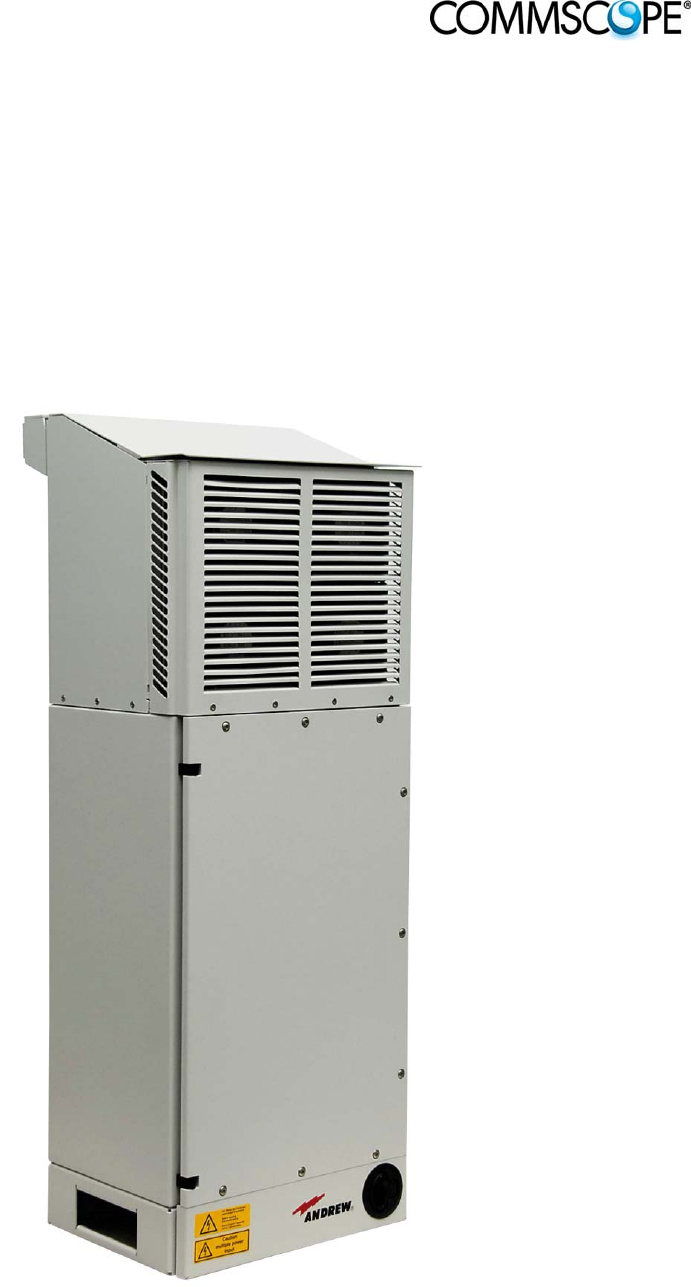
Optical Remote Unit
ION™-M7HP/7HP/85HP/19P
(W1-cabinet)
Manual
MF0145A8A
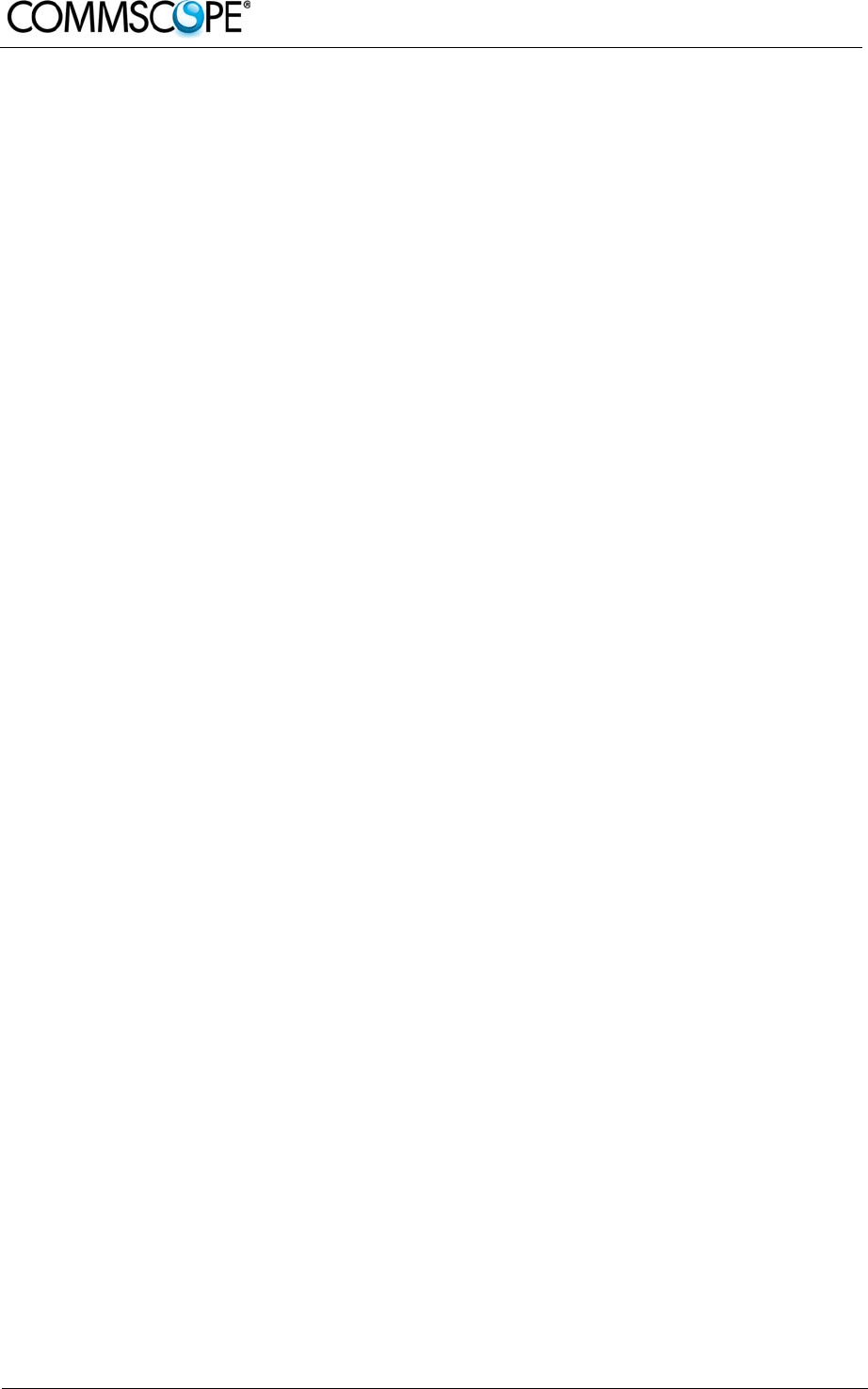
Manual for
ION-M7HP/7HP/85HP/19P (W1-Cabinet)
Page 2 MF0145A8A_FCC modif.doc
© Copyright 2012 CommScope, Inc.
All rights reserved.
CommScope Solutions is a trademark of CommScope, Inc.
All information contained in this manual has been revised thoroughly. Yet
CommScope Solutions accepts no liability for any omissions or faults.
CommScope Solutions reserves the right to change all hardware and software
characteristics without notice.
Names of products mentioned herein are used for identification purposes only and
may be trademarks and / or registered trademarks of their respective companies.
No parts of this publication may be reproduced, stored in a retrieval system,
transmitted in any form or by any means, electronical, mechanical photocopying,
recording or otherwise, without prior written permission of the publisher.
Andrew Wireless Systems GmbH, 03-May-2012

Page 3
TABLE OF CONTENTS
1. GENERAL 5
1.1. USED ABBREVIATIONS 5
1.2. HEALTH AND SAFETY WARNINGS 6
1.3. ABOUT COMMSCOPE SOLUTIONS 8
1.4. INTERNATIONAL CONTACT ADDRESSES FOR CUSTOMER SUPPORT 9
2. INTRODUCTION 12
2.1. PURPOSE 12
2.2. THE ION-M7HP/7HP/85HP/19P (INTELLIGENT OPTICAL NETWORK; MMR) 12
2.3. VSWR ALARMING OPTION 13
3. COMMISSIONING 15
3.1. MECHANICAL INSTALLATION 15
3.1.1. General 15
3.1.2. Wall-Mounting Procedure 17
3.2. ELECTRICAL INSTALLATION 18
3.2.1. General 18
3.2.2. Connections 19
3.2.3. Grounding 20
3.2.4. Connection of the Antenna Cables 20
3.2.5. Connection of AC Mains Power 21
3.2.6. Connection of Optical-Fibre-Cable - Rules 22
3.2.7. Protective Plug 24
3.2.8. Protective-Tube Kit 26
3.2.9. Connection of External-Alarms Cable 28
3.3. COMMISSIONING 29
4. ALARMS 33
4.1. BITE AND ALARMS 33
4.2. HANDLING OF ALARMS 33
4.3. ALARM STATUS 33
4.4. STATUS LED ALARMS 33
4.5. APPLICATION BOARD 35
4.5.1. External-Alarm Inputs and Outputs 35
4.5.2. Layout and Connector Description 36
4.6. TROUBLESHOOTING 38
5. MAINTENANCE 39
5.1. GENERAL 39
5.2. REPLACING THE FAN UNIT 40

Manual for
ION-M7HP/7HP/85HP/19P (W1-cab)
Page 4 MF0145A8A_FCC modif.doc
5.3. CLEANING THE HEAT SINK 42
6. APPENDIX 43
6.1. ILLUSTRATIONS 43
6.2. SPECIFICATIONS 43
6.2.1. Electrical Specifications 43
6.2.2. Mechanical Specifications 43
6.2.3. Environmental and Safety Specifications 44
6.3. SPARE PARTS 44
7. INDEX 45
FIGURES AND TABLES
figure 3-1 Wall mounting........................................................................................... 17
figure 3-2 Connector flange of ION-M7HP/7HP/85HP/19P....................................... 19
figure 3-3 Caution labels........................................................................................... 19
figure 3-4 Grounding bolt with loosened hex nut, exemplary.................................... 20
figure 3-5 Grounding bolt, schematic view................................................................ 20
figure 3-6 Position of AC mains connectors at connector flange .............................. 21
figure 3-7 AC mains plug, front view......................................................................... 21
figure 3-8 Protective-plug assembly ......................................................................... 24
figure 3-9 Tube-kit installation................................................................................... 27
figure 4-1 External-alarm inputs and outputs, location.............................................. 36
figure 4-2 Application board, connectors .................................................................. 36
figure 4-3 External-alarm outputs, relay contacts in alarm condition ........................ 37
figure 4-4 28 V DC connector, location on distribution board ................................... 38
figure 6-1 Cabinet drawing........................................................................................ 43
table 1-1 List of international contact addresses....................................................... 11
table 3-1 Specified torques....................................................................................... 16
table 4-1 Status LED alarms..................................................................................... 34

Page 5 MF0145A8A_FCC modif.doc
1. GENERAL
1.1. USED ABBREVIATIONS
3GPP 3rd Generation Partnership Project
AC/DC Alternating current / Direct Current
AIMOS Andrew Integrated Management and Operating System
ALC Automatic Level Control
BITE Built-In Test Equipment
BTS Base Transceiver Station
CE "Conformité Européenne" ("European Conformity")
CD Compact Disk
CPD Channel Power Detection
DL Downlink
DoC Declaration of Conformity
EDGE Enhanced Data Rates for GSM Evolution
EN European Norm
EP Extension Port
ESD Electrostatic Discharge
ETS European Telecommunication Standard
EU Extension Unit
GSM Global System for Mobile Communication
GND Ground
GUI Graphical User Interface
ICP3 Intercept Point 3rd order
ID No Identification Number
ION Intelligent Optical Network
IP Ingress Protection
ISO International Organization for Standardization
LED Light Emitting Diode
LMT Local Maintenance Terminal
LTE Long Term Evolution
MIMO Multiple Input Multiple Output
MS Mobile Station
MU Main Unit
NF Noise Figure
OTRx Optical Transceiver = SRMU (Subrack Master Unit)
PDU Power Distribution Unit
PG Packing Gland
PIM Passive Intermodulation
Pin Input power
Pout Output power
R&TTE Radio & Telecommunications Terminal Equipment
Rev Revision
RF Radio Frequency
RU Remote Unit
RX Receiver
SNMP Simple Network Management Protocol
TS Technical Specification
TX Transmitter
UL Uplink
UMTS Universal Mobile Telecommunication System
UPS Uninterruptible Power Supply
VSWR Voltage Standing Wave Ratio
WCDMA Wideband Code Division Multiple Access
WDM Wavelength Division Multiplex

1.2. HEALTH AND SAFETY WARNINGS
1. Only suitably qualified personnel is allowed to work on this unit and only after
becoming familiar with all safety notices, installation, operation and maintenance
procedures contained in this manual.
2. Read and obey all the warning labels attached to the unit. Make sure that the
warning labels are kept in a legible condition and replace any missing or
damaged labels.
3. Obey all general and regional installation and safety regulations relating to work
on high voltage installations, as well as regulations covering correct use of tools
and personal protective equipment.
4. Keep operating instructions within easy reach and make them available to all
users.
5. It is the responsibility of the network provider to implement prevention measures
to avoid health hazards which may be associated to radiation from the antenna(s)
connected to the unit.
6. Note for a Class A digital device or peripheral:
This equipment has been tested and found to comply with the limits for a
Class A digital device, pursuant to part 15 of the FCC Rules. These limits
are designed to provide reasonable protection against harmful interference
when the equipment is operated in a commercial environment. This
equipment generates, uses, and can radiate radio frequency energy and, if
not installed and used in accordance with the instruction manual, may
cause harmful interference to radio communications. Operation of this
equipment in a residential area is likely to cause harmful interference in
which case the user will be required to correct the interference at his own
expense.
7. Make sure, access is restricted to qualified personnel.
8. Only licence holders for the respective frequency range are allowed to operate
this unit.
9. Corresponding local particularities and regulations must be observed. For national
deviations please refer to the respective documents included in the manual CD
delivered.
10. Use this equipment only for the purpose specified by the manufacturer. Do not
carry out any modifications or fit any spare parts which are not sold or
recommended by the manufacturer. This could cause fires, electric shock or other
injuries.
11. Due to power dissipation, the repeater may reach a very high temperature. Do not
operate this equipment on or close to flammable materials.
Page 6 MF0145A8A_FCC modif.doc
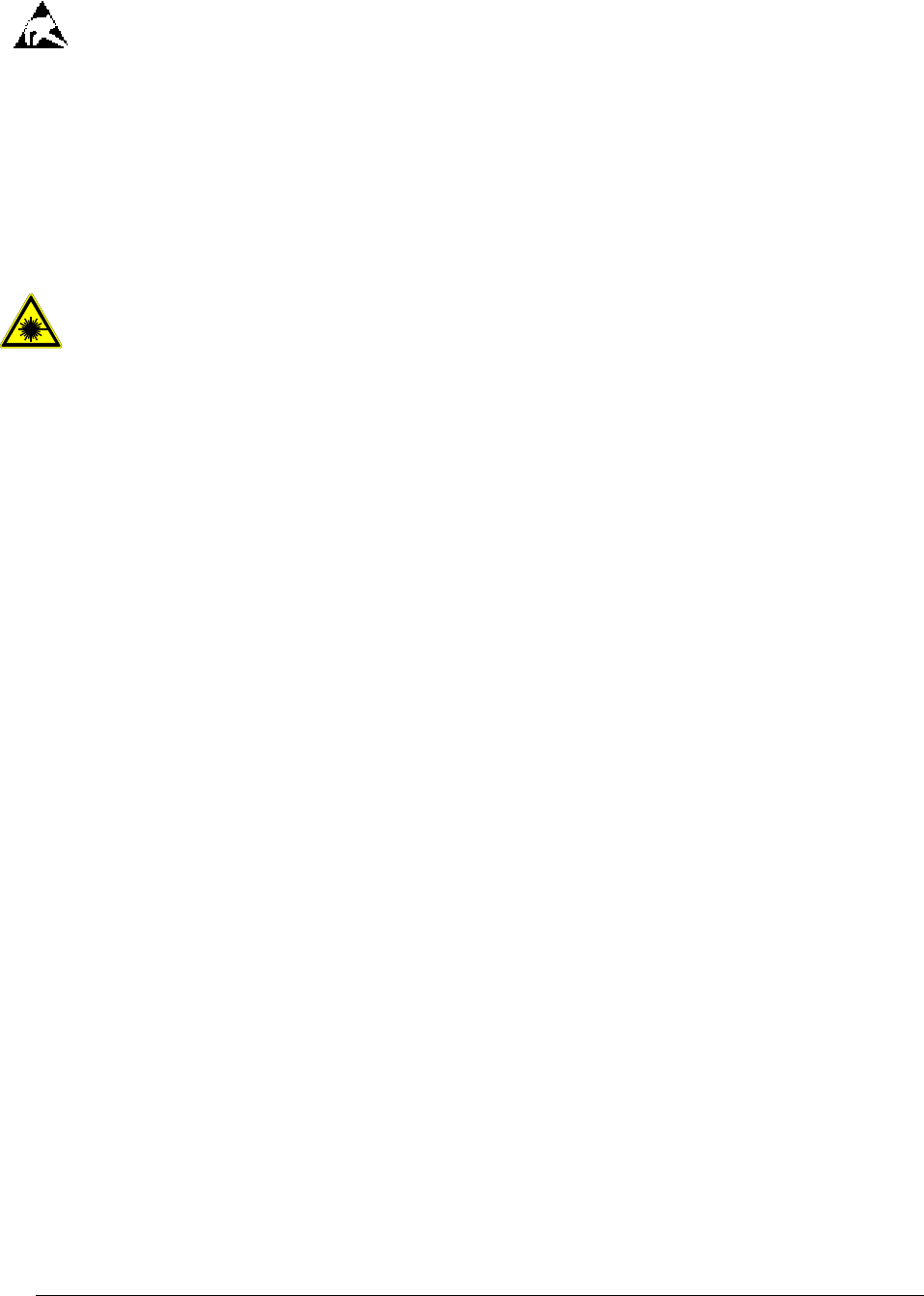
12. Before opening the unit, disconnect mains.
13. ESD precautions must be observed! Before commencing maintenance work, use
the available grounding system to connect ESD protection measures.
14. This unit complies with European standard EN60950.
15. Make sure the repeater settings are according to the intended use (see also
product information of manufacturer) and regulatory requirements are met.
16. Although the repeater is internally protected against overvoltage, it is strongly
recommended to earth the antenna cables close to the repeater’s antenna
connectors for protection against atmospheric discharge.
17. Laser radiation! Do not stare into the beam; do not view it directly or with optical
instruments.
Page 7 MF0145A8A_FCC modif.doc

Page 8 MF0145A8A_FCC modif.doc
1.3. ABOUT COMMSCOPE SOLUTIONS
CommScope Solutions is the foremost supplier of one-stop, end-to-end radio
frequency (RF) solutions. Our products are complete solutions for wireless
infrastructure from top-of-the-tower base station antennas to cable systems and
cabinets, RF site solutions, signal distribution, and network optimization.
CommScope Solutions has global engineering and manufacturing facilities. In
addition, it maintains field engineering offices throughout the world.
Andrew Wireless Systems GmbH based in Buchdorf/ Germany, which is part of
CommScope Solutions, is a leading manufacturer of coverage equipment for mobile
radio networks, specializing in high performance, RF and optical repeaters. Our
optical distributed networks and RF repeater systems provide coverage and capacity
solution for wireless networks in both indoor installations and outdoor environments,
e.g. tunnels, subways, in-trains, airport buildings, stadiums, skyscrapers, shopping
malls, hotels and conference rooms.
Andrew Wireless Systems GmbH operates a quality management system in
compliance with the requirements of ISO 9001 and TL 9000. All equipment is
manufactured using highly reliable material. To maintain highest quality of the
products, comprehensive quality monitoring is conducted at all fabrication stages.
Finished products leave the factory only after a thorough final acceptance test,
accompanied by a test certificate guaranteeing optimal operation.
Note: Exceptions of and national deviations from this intended use may be
possible. To observe corresponding local particularities and
regulations, please refer to the respective documents (also in
national language) which are included in the manual CD delivered.
To make the most of this product, we recommend you carefully read the instructions
in this manual and commission the system only according to these instructions.
For technical assistance and support, please also contact the local office or
CommScope Solutions directly at one of the addresses listed in the following chapter.

Page 9 MF0145A8A_FCC modif.doc
1.4. INTERNATIONAL CONTACT ADDRESSES FOR CUSTOMER SUPPORT
Americas:
Canada United States
CommScope Solutions Canada Andrew LLC, A CommScope Company
Mail 505 Consumers Road, Suite 803
Toronto M2J 4V8
Canada Mail 620 North Greenfield Parkway
Garner, NC 27529
U.S.A.
Phone +1-905-878-3457 (Office)
+1-416-721-5058 (Cell) Phone +1-888-297-6433
Fax +1-905-878-3297 Fax +1-919-329-8950
E-mail Peter.Masih@commScope.com,
wisupport.us@commScope.com
E-mail wisupport.us@commScope.com
Caribbean & South American Region
(CALA) Caribbean (CALA) & Central American
Region
CommScope Cabos do Brasil Ltda. CommScope Mexico S.A. de C.V.
Mail
CALA Tech Support for Distributed
Coverage & Capacity Solutions
(DCCS) products:
Rua Guaporanga, 49
Praça Seca – Rio de Janeiro – RJ
ZIP: 21320-180
Brazil
Mail
CALA Tech Support for Distributed
Coverage & Capacity Solutions
(DCCS) products:
Av. Insurgentes Sur 688, Piso 6
Col. Del Valle, CP: 03100
Mexico City
Mexico
Phone +1-815-546-7154 (Cell)
+55-15-9104-7722 (Office) Phone +52-1-55-5419-5260 (Cell)
+52-55-1346-1900 (Office)
Fax + 55-15-2102-4001 Fax +52-55-1346-1901
E-mail wisupport@commScope.com
E-mail wisupport@commScope.com
APAC Countries:
China, India and Rest of Asia Australia & New Zealand
Andrew International Corporation Andrew Corporation (Australia) Pty Ltd.
Mail
Room 915, 9/F
Chevalier Commercial Centre
8 Wang Hoi Rd
Kowloon Bay
Hong Kong
Mail
Unit 1
153 Barry Road
Campbellfield
VIC 3061
Australia
Phone +852-3106-6100 Phone +613-9300-7969
Fax +852-2751-7800 Fax +613-9357-9110
E-mail wisupport.China@commScope.com
E-mail wisupport.Australia@commScope.com

Page 10 MF0145A8A_FCC modif.doc
Europe:
United Kingdom Scandinavia
Andrew Wireless Systems UK Ltd Andrew Norway (AMNW)
Mail
Unit 15, Ilex Building
Mulberry Business Park
Fishponds Road
Wokingham Berkshire
RG41 2GY
England
Mail
P.O. Box 3066
Osloveien 10
Hoenefoss 3501
Norway
Phone +44-1189-366-792 Phone + 47 32-12-3530
Fax +44-1189-366-773 Fax + 47 32-12-3531
E-mail wisupport.uk@commScope.com
E-mail wisupport@commScope.com
Germany France
Andrew Wireless Systems GmbH CommScope France
Mail Industriering 10
86675 Buchdorf
Germany Mail
Immeuble Le Lavoisier
4, Place des Vosges
92052 Courbevoie
France
Phone +49-9099-69-0 Phone +33-1 82 97 04 00
Fax +49-9099-69-930 Fax +33-1 47 89 45 25
E-mail wisupport@commScope.com
E-mail wisupport@commScope.com
Austria Switzerland
Andrew Wireless Systems (Austria) GmbH Andrew Wireless Systems AG
Mail Weglgasse 10
2320 Wien-Schwechat
Austria Mail Tiergartenweg 1
CH-4710 Balsthal
Switzerland
Phone +43-1706-39-99-10 Phone +41-62-386-1260
Fax +43-1706-39-99-9 Fax +41-62-386-1261
E-mail wisupport.austria@commScope.com
E-mail wisupport.ch@commScope.com
Italy Iberia Region - Spain & Portugal
CommScope Italy S.r.l., Faenza, Italy Andrew España S.A.
A CommScope Company
Mail Via Mengolina, 20
48018 Faenza (RA)
Italy Mail
Avda. de Europa, 4 - 2ª pta.
Parque Empresarial de la Moraleja
Alcobendas, Madrid 28108
Spain
Phone +39-0546-697111 Phone +34-91-745-20 40
Fax +39-0546-682768 Fax +34-91-661-87 02
E-mail wisupport.italia@commScope.com
E-mail wisupport.iberia@commScope.com

Page 11 MF0145A8A_FCC modif.doc
Czech Republic
CommScope Solutions Czech Republic
C-Com, spol. s r.o
Mail U Moruší 888
53006 Pardubice
Czech Republic
Phone +49 871 9659171 (Office)
+49 171 4001166 (Mobile)
Fax +49 871 9659172
E-mail wisupport@commScope.com
Africa & Middle East:
Middle East & North Africa South Africa
CommScope Solutions International Inc.
(Branch) Andrew Wireless Solutions Africa (PTY)
LTD
Mail
PO Box 48 78 22
Unit 3206, Floor 32,
Jumeirah Business Center 5,
Jumeirah Lakes Towers,
Dubai
United Arab Emirates
Mail
11 Commerce Crescent West
Eastgate, Sandton
PO Box 786117
Sandton 2146
South Africa
Phone +971 4 390 09 80 Phone + 27 11-719-6000
Fax +971 4 390 86 23 Fax + 27 11-444-5393
E-mail wisupport@commScope.com
E-mail wisupport@commScope.com
table 1-1 List of international contact addresses

Page 12 MF0145A8A_FCC modif.doc
2. INTRODUCTION
2.1. PURPOSE
Cellular telephone systems transmit signals in two directions between a base
transceiver station (BTS) and mobile stations (MS) within the signal coverage area.
If weak signal transmissions occur within the coverage area because of indoor
applications, topological conditions or distance from the transmitter, extension of the
transmission range can be achieved by means of an optical distribution system.
Such a system contains an optical Master Unit and several Remote Units. The
number of the Remote Units depends on the hardware and software configuration.
The Remote Units are connected to the Master Unit with optical links. The optical
loss must be less than 10 dB inclusive optical couplers or splitters.
The Master Unit is the connection to the base transceiver stations. The configuration
of a Master Unit depends on the number of the Remote Units and the frequency
range.
WDM (Wave Division Multiplex) filters are integrated in the optical modules. For the
UL, a wavelength within 1540 nm - 1562 nm is used. For the DL, a wavelength of
1310 ±20 nm is used. The maximum output power for the UL and DL is 5.7 mW.
2.2. THE ION-M7HP/7HP/85HP/19P (INTELLIGENT OPTICAL NETWORK;
MMR)
The ION-M7HP/7HP/85HP/19P is an LTE MIMO, 850 MHz, and 1900 MHz
CDMA/WCDMA multi-operator Remote Unit. It is used in conjunction with a Master
Unit in the ION optical distribution system. This system transports LTE channels, and
CDMA 850 MHz; and 1900 MHz signals simultaneously, providing a cost-effective
solution for distributing capacity from one or more base stations.
The ION-M7HP/7HP/85HP/19P transports signals on the RF layer in a very
inexpensive manner. This means that multiple operators and multiple technologies
are moved simultaneously from a cluster of base stations to a remote location over
the same fiber.
The ION optical distribution system is a cost-effective coverage solution for dense
urban areas, tunnels, subway, airports, convention centers, high-rise buildings and
other locations where physical structures increase path loss. It has been specifically
designed to reduce zoning problems and to provide homogeneous coverage. The
compact, mechanical design is specifically architected to mount along side structures
in such a way that it has a minimal visual impact.

Page 13 MF0145A8A_FCC modif.doc
The ION is easily set-up and supervised via a graphical user interface (GUI). Remote
units can be commissioned through the use of built-in test equipment. An auto-
leveling function compensates for the optical link loss making installation easy and
quick. The entire system may be monitored remotely via an Andrew OMC. This
platform uses SNMP protocol and is compliant to X.733 standard.
Should a sophisticated interface not be required, the master unit can be
directly connected to the alarm interface of a base station via its contact relay.
Features:
Multi-channel, multi-operator support
Reduced visual impact form factor
Efficient, high power amplifiers
Single fiber for MIMO and multiple remotes
Comprehensive operations and management system for configuration and
alarming
OMC with SNMP according to X.733 standard
3GPP TS25.143/TS25.106/ TS36.143/TS36.106 and 3GPP2C.S0051-0
compliant
Easy installation and commissioning
2.3. VSWR ALARMING OPTION
The VSWR Alarming Option is a remote-controlled data acquisition system for
monitoring the VSWR of the 700 MHz LTE antenna interfaces. The differential power
detector compares the power levels corresponding with the forward and reverse
waves at the antenna interfaces. A VSWR alarm is always initiated in case of return
loss lower than 2 dB. Return loss higher than 10 dB corresponds always with normal
operation without defect. The return loss range between 2 and 10 dB is the ambiguity
range, depending on the specific phase conditions at the antenna interfaces.

Page 14 MF0145A8A_FCC modif.doc
For your notes:
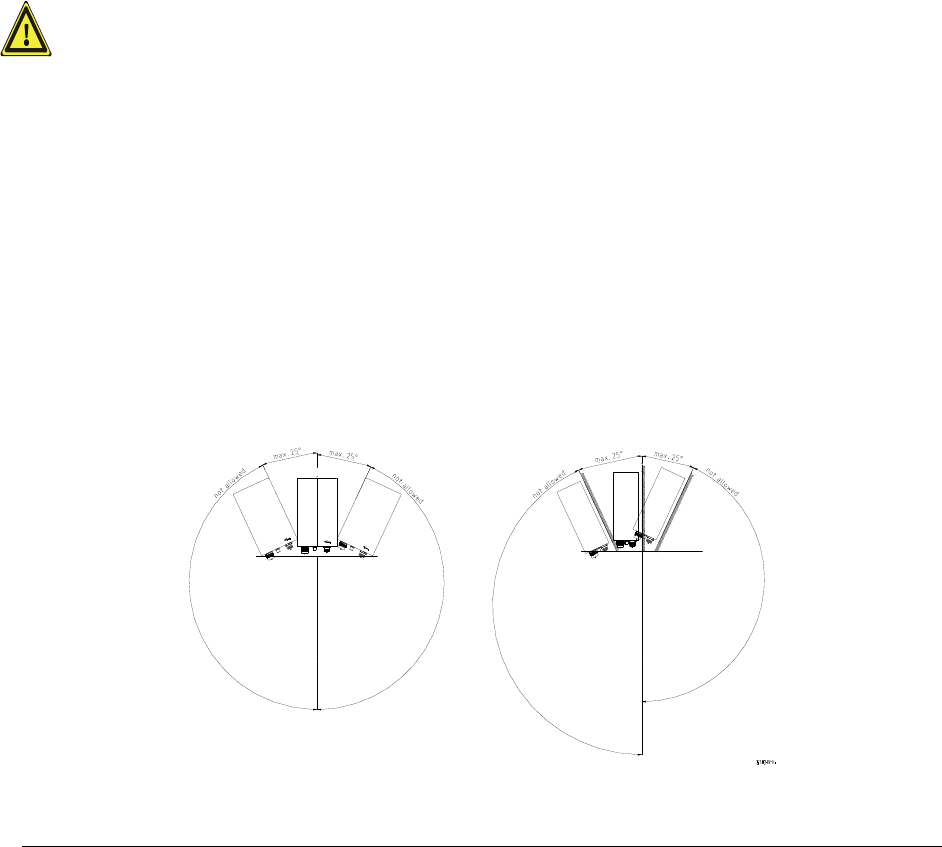
3. COMMISSIONING
3.1. MECHANICAL INSTALLATION
3.1.1. General
Read the health and safety warnings in chapter 1.2 Health and Safety Warnings .
1. Do not install the unit in a way or at a place where the specifications
outlined in the Environmental and Safety Specifications leaflet of the
supplier are not met.
2. It is recommended only to use the mounting hardware delivered by the
supplier. If different mounting hardware is used, the specifications for
stationary use of the Remote Unit must not be exceeded.
Note: Exceeding the specified load limits may cause the loss of warranty!
3. The unit is considerably heavy. Make sure that a suitable mounting surface
is used. Ensure there is adequate manpower to handle the weight of the
system.
4. Due to power dissipation, the Remote Unit may reach a very high
temperature. Ensure sufficient airflow for ventilation as specified in the
individual mounting procedures.
5. When connecting and mounting the cables (RF, optical, mains, ...) ensure
no water can penetrate into the unit through these cables.
6. Also observe all additional rules or restrictions regarding mounting that
depend on the type of Remote Unit. For details refer to chapter 7.2.2
Mechanical Specification. Install the unit vertically with the fan unit at the
top. A maximum tilt angle of 25° from a vertical position must be kept, as in
the following illustrations:
Page 15 MF0145A8A_FCC modif.doc
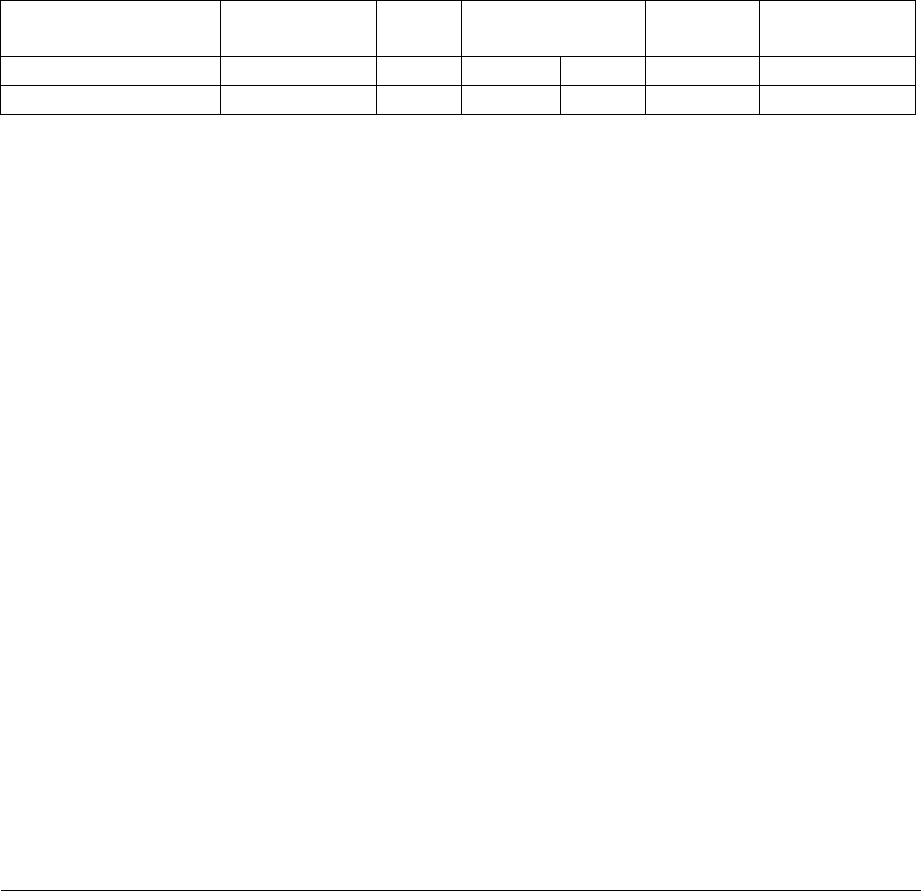
Page 16 MF0145A8A_FCC modif.doc
7. A spacing of 40 mm (1.58 inch) around the unit is required.
8. To ensure sufficient airflow when mounting the unit in enclosed spaces, two
lid openings (one for the air inlet and the other for the air outlet) have to be
provided. Do not block these air inlets and outlets when mounting the
Remote Unit. The size of each opening must equal at least 17 x 17 cm
(290 cm2). Make sure, too, there is no thermal short circuit between the air
inlet and air outlet.
If any different or additional mounting material is used, ensure that the mounting
remains as safe as the mounting designed by the manufacturer. Ensure that the
static and dynamic strengths are adequate for the environmental conditions of the
site. The mounting itself must not vibrate, swing or move in any way that might cause
damage to the Remote Unit.
Specified torques have to be observed for certain mounting procedures according to
the following table:
Type Tallow-drop
screws Hex
nuts Spacing
bolts PG
(plastic) PG
(aluminium)
Thread M 4 M 8 M 4 M 8 PG 13.5 PG 29
Specified torques 3.3 Nm 27 Nm 2.3 Nm 27 Nm 3.75 Nm 10 Nm
table 3-1 Specified torques
Note: To avoid damage when mounting the unit, always make sure that
the M8 washers (DIN9021 or DIN125 depending on the mounting kit)
are placed behind and in front of the mounting drillings of the unit.
The mounting procedures for a stand-alone Remote Unit without optional
accessories are described and illustrated in the following sections. For further
information regarding special mounting procedures including mounting of accessory
equipment, please see separate manual.
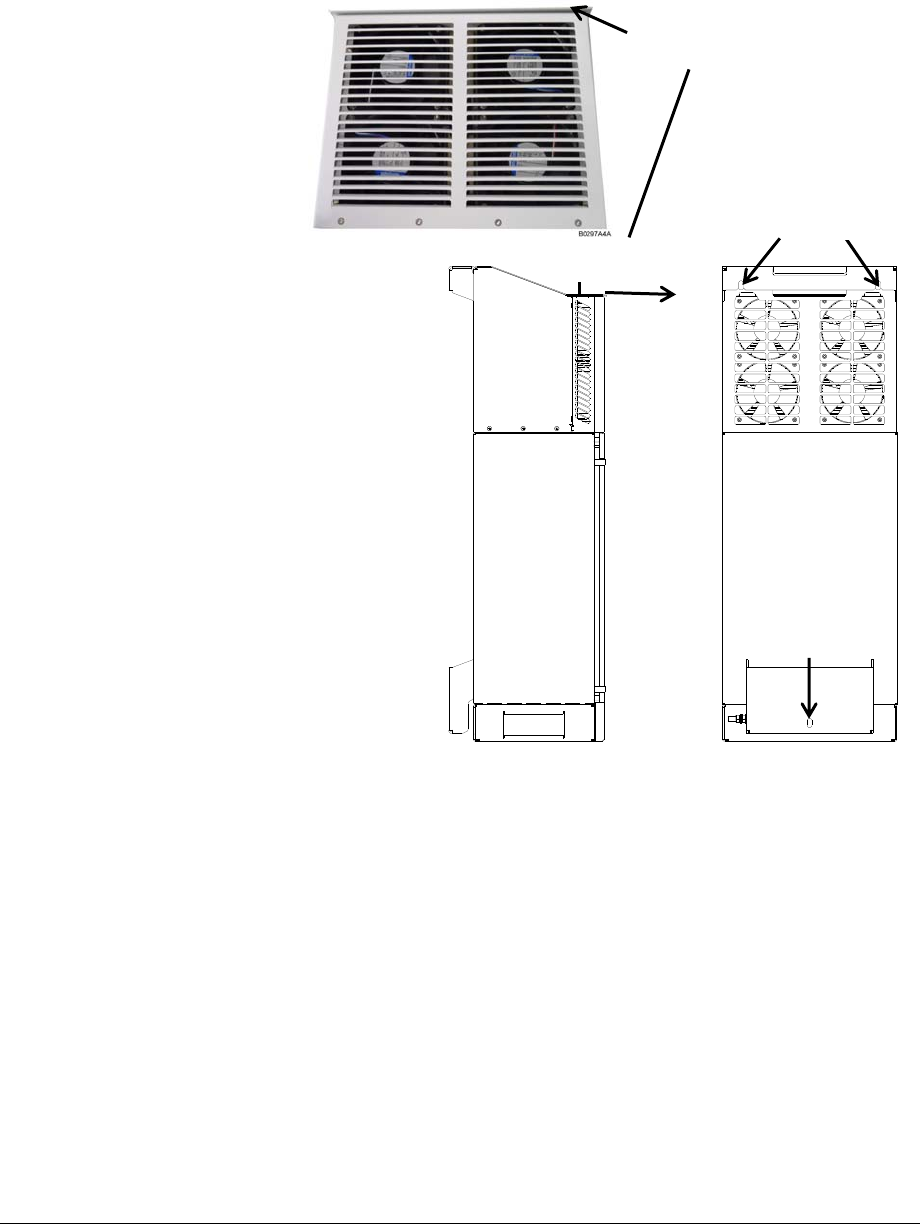
3.1.2. Wall-Mounting Procedure
Check the suitability of the wall-mounting kit and the wall.
Remove the protective cover from the top of the Remote Unit by pulling it
strongly to the front.
Page 17 MF0145A8A_FCC modif.doc
Mark the position of the drilling
holes (for exact measurements
refer to the wall mounting plan
that is part of the delivery). Drill
three holes at the marked
positions and insert dowels*.
Choose the screw type you
want to use: two possible sets
are provided in the kit; for
details see mounting plan.
Screw two screws with the
according washers / nuts into
the two upper dowels but do not
fasten them.
Hang the Remote Unit with the
two upper holes into the upper
screws and, then, fasten them
tight using an appropriate tool.
figure 3-1 Wall mounting
* The dowels are not part of the delivery since the suitable type depends on the on-site conditions
(material of wall). Therefore, use dowels that are appropriate for the mounting surface.
Then, put the third screw with the according washers / nuts through the bottom
hole of the Remote Unit and screw it into the third dowel using an appropriate
tool.
Put the protective cover back on top of the Remote Unit.
Ensure that there is free access to the electrical connections as well as to the
cabinet. The approved bending radius of the connected cables must not be
exceeded.
Bottom hole
Upper holes
Protective cover
Pull strongly!

3.2. ELECTRICAL INSTALLATION
3.2.1. General
Read the health and safety warnings in chapter 1.2.
1. This unit contains dangerous voltages. Loss of life, severe personal injury or
property damage can be the result if the instructions contained in this manual are
not followed.
2. It is compulsory to ground the unit before connecting power supply. A grounding
bolt is provided on the cabinet to connect the ground-bonding cable.
3. Although the Remote Unit is internally protected against overvoltage, it is strongly
recommended to earth the antenna cables close to the antenna connectors of the
Remote Unit for protection against atmospheric discharge. In areas with strong
lightning it is strongly recommended to insert additional lightning protection.
4. If the mains connector of the Remote Unit is not easily accessible, a disconnect
device in the mains circuit must be provided within easy reach.
5. Before connecting or disconnecting the mains connector at the Remote Unit,
ensure that mains supply is disconnected.
6. Make sure that an appropriate branch circuit breaker and an overcurrent limiting
device are connected between mains and Remote Unit.
7. An external circuit breaker is mandatory as disconnect device. This circuit breaker
should be readily available for the operator.
For the U.S. and Canada, installation has to be done in accordance with the NEC
(National Electronic Code). The external circuit breaker has to be a branch circuit
breaker rated 20 A for 110 Vac mains.
8. A field wiring box with conduit must be used for the installation. Use a wire
harness rated for AC mains with at least AWG14 size.
9. A connection of mains supply to a power socket requires the power socket to be
nearby the Remote Unit.
10. Incorrectly wired connections can destroy electrical and electronic components.
11. To avoid corrosion at the connectors caused by electrochemical processes, the
material of the cable connectors must not cause a higher potential difference than
0.6 V (see electrochemical contact series).
12. Use an appropriate torque wrench for the coupling torque (25 N-m / 19 ft lb) of
7/16-DIN connectors with 1 ¼-inch opening to tighten the 7/16-type antenna
connectors. For example, use torque wrench of item no. 244377 available from
the Andrew e-catalog. Do NOT use your hands or any other tool (e.g. a pair of
pliers)! This might cause damage to the connector and lead to a malfunction of
the Remote Unit.
13. For unstabilized electric networks which frequently generate spikes, it is advised
to use a voltage limiting device.
Page 18 MF0145A8A_FCC modif.doc
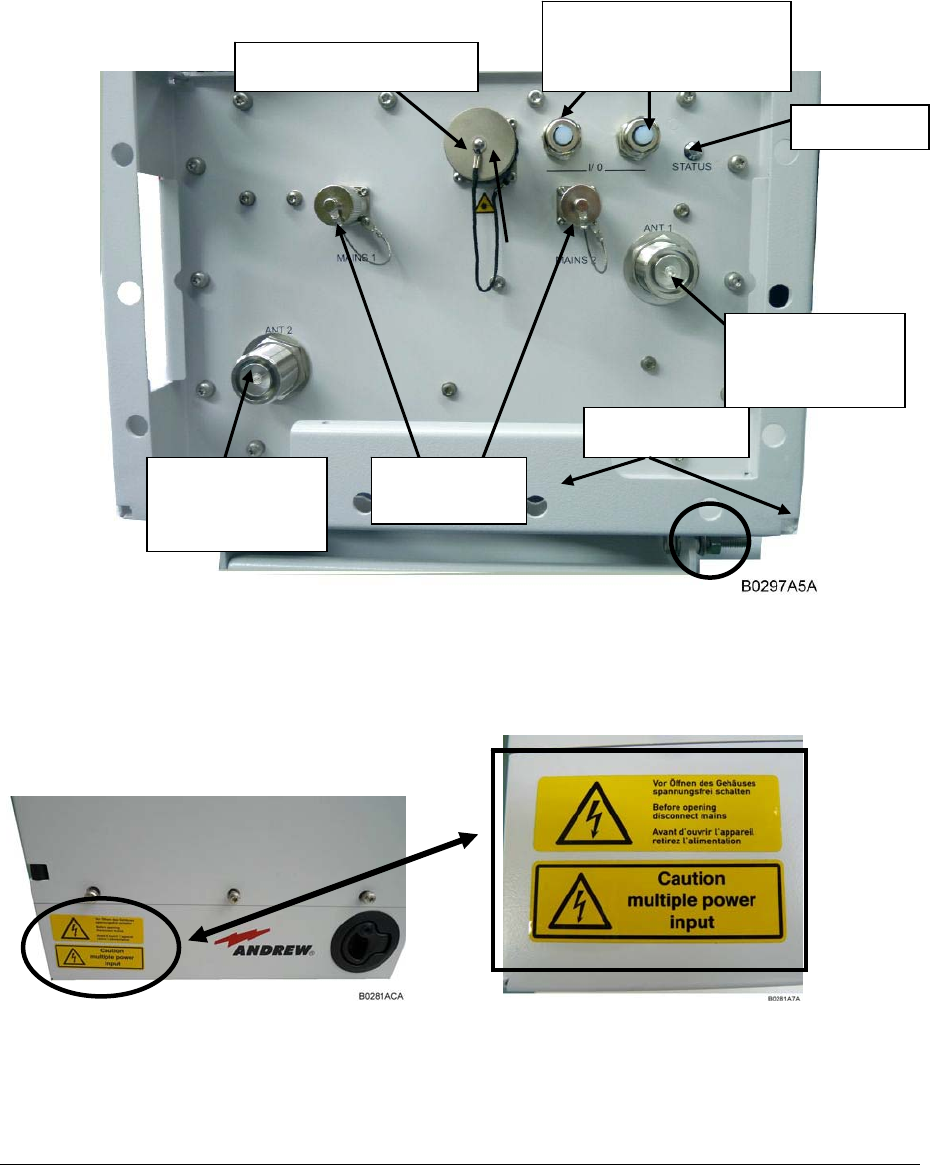
14. The unit complies with the surge requirement according to EN 61000-4-5 (fine
protection); however, it is recommended to install an additional medium (via local
supply connection) and/or coarse protection (external surge protection) depending
on the individual application in order to avoid damage caused by overcurrent.
15. Observe the labels on the front panels before connecting or disconnecting any
cables!
3.2.2. Connections
Page 19 MF0145A8A_FCC modif.doc
figure 3-2 Connector flange of ION-M7HP/7HP/85HP/19P
Please observe the following two caution labels attached to the unit cabinet:
figure 3-3 Caution labels
Cable glands for
connection of external
alarms inputs/ outputs
Optical-fibre connector
Status LED
7/16-connector
Mobile 1
700 MHz
Grounding bolt
Mains
connectors
7/16-connector
Mobile 2
1900 MHz
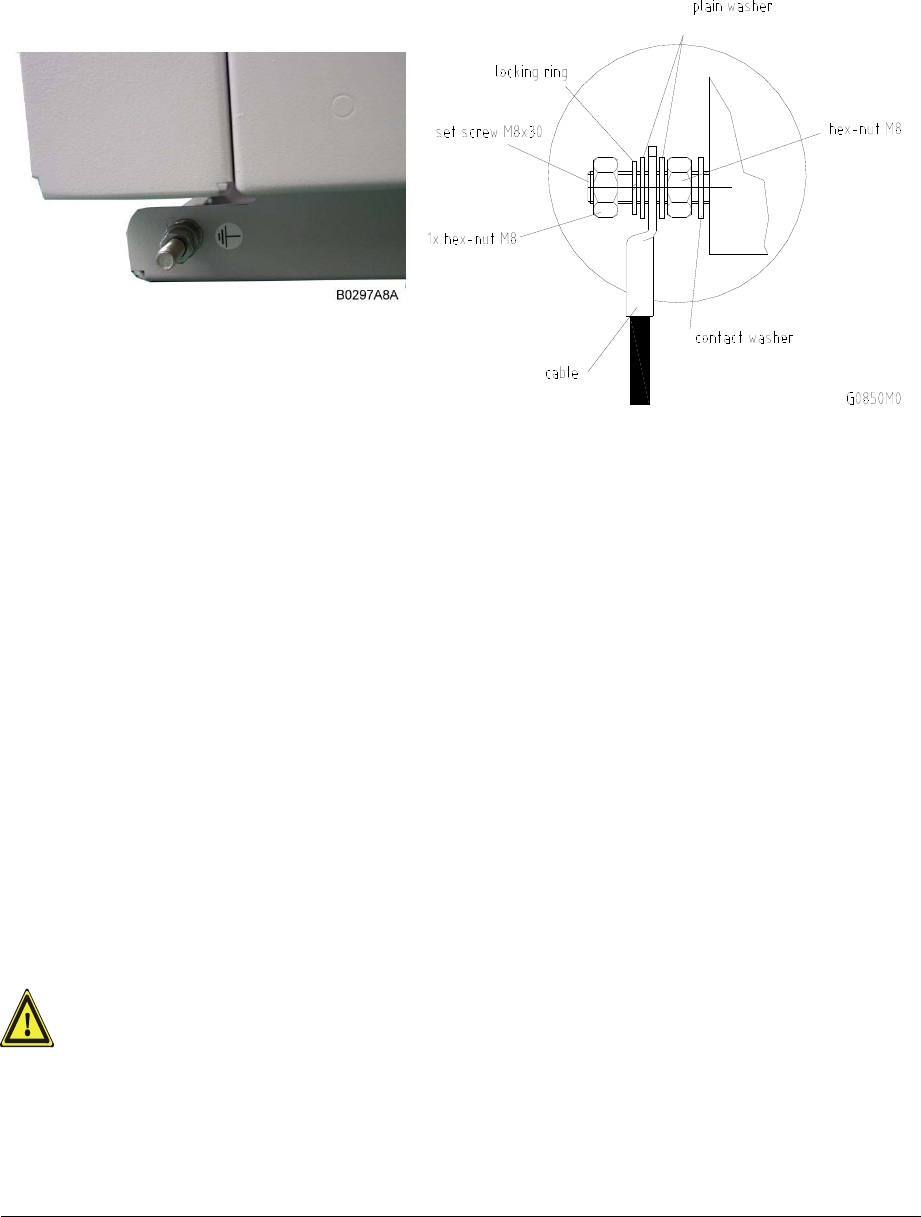
3.2.3. Grounding
Grounding must be carried out. Connect an earth-bonding cable to the grounding
connection provided at the outside of the Remote Unit (see chapter 3.2.2
Connections). Do not use the grounding connection to connect external devices.
figure 3-4 Grounding bolt with
loosened hex nut, exemplary figure 3-5 Grounding bolt, schematic view
After loosening the hex nut, connect the earth-bonding cable between the two
washers as illustrated in the figures above. Then, fasten all parts again with the hex
nut.
3.2.4. Connection of the Antenna Cables
The Remote Unit has 7/16-type antenna connectors. For its location please refer to
chapter 3.2.2 Connections. For mounting the cable connectors, it is recommended to
refer to the corresponding documentation of the connector manufacturer. The
bending radius of the antenna cables must remain within the given specifications.
For the selection of cable and antenna it should be considered that, on the one hand,
a cable with higher loss is less expensive but, on the other hand, it impairs
performance.
It is sufficient to tighten the 7/16-type antenna connectors hand-tight. The use
of a tool (like pliers) may cause damage to the connector and, therefore, lead
to a malfunctioning of the Remote Unit.
Page 20 MF0145A8A_FCC modif.doc
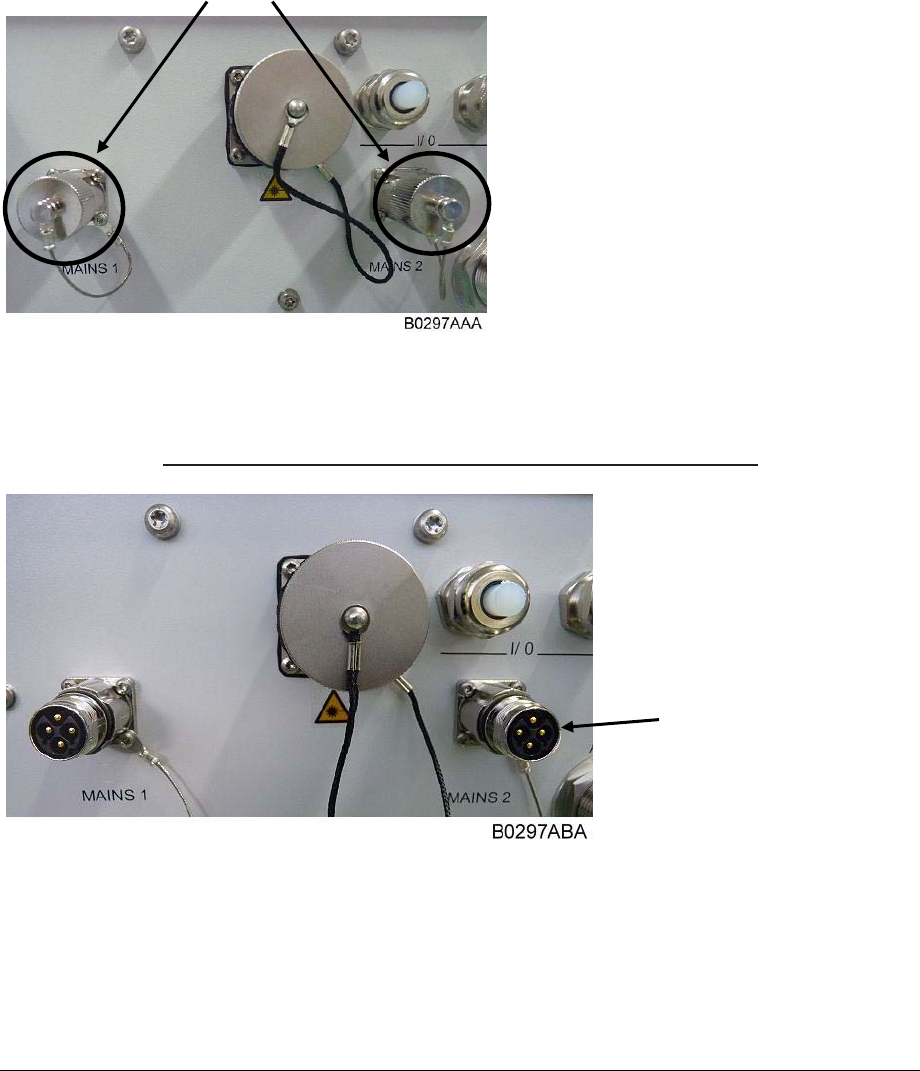
3.2.5. Connection of AC Mains Power
Before connecting electrical power to the units, the system must be grounded as
described in the previous chapter.
Mains power must be connected at the mains connectors of the unit (see chapter
3.2.2 Connections).
The power supply plug is part of the delivery. The correct wiring of the power supply
plug is as follows:
2 AC mains cable connector
Cover of mains connectors
fastened =>
Remove cover(s) to access
PINs!
figure 3-6 Position of AC mains connectors at connector flange
Mains 1 + 2 Power Connectors- AC PIN Assignment:
Cover of
mains connectors
removed
figure 3-7 AC mains plug, front view
Page 21 MF0145A8A_FCC modif.doc
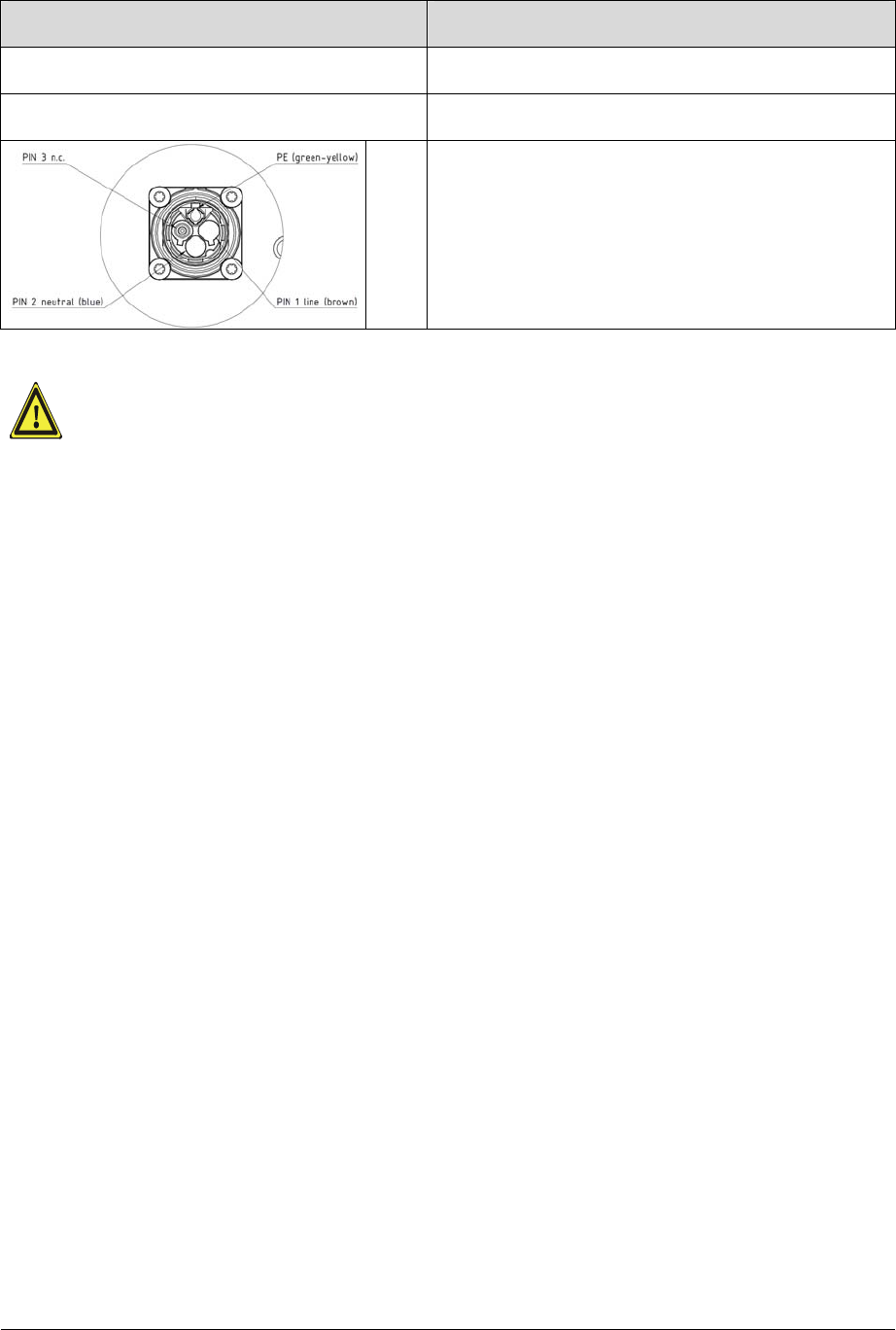
Parameter Value
Label / Name MAINS 1
MAINS 2
Connector type CONINVERS M 17 series P20
4(3+PE) PINs male
PIN
1
2
3
4
L – Line conductor / Phase 1 (brown cable)
N – Neutral conductor (blue cable)
not connected (n.c.)
PE – Protection Earth (green / yellow cable)
For the AC power supply connection, a minimum cross section of 1.5
mm2 is required. Each wire must observe the applicable national
regulations regarding loop impedance, voltage drop, and methods of
installation. Make sure to connect the correct voltage to the unit.
Note: Do not connect or disconnect the power cord at the mains connector
while power is on. Turn off mains power* before connecting the
power cord at the remote unit, then, engage mains again.
* Mains power must be interruptible with an external mains breaker. For the mains breaker,
observe the following recommendation:
120 Volt / 20 Amp max. or 240 Volt / 16 Amp, single-phase, 50 / 60 Hz AC service is needed,
i.e. the external AC breaker should be 20 Amps max. for 120-Volt service or 16 Amps for 240-
Volt service.
3.2.6. Connection of Optical-Fibre-Cable - Rules
Optical signals are transmitted by use of optical fibres. When connecting these fibres
observe the following instructions.
Note: Care should be taken when connecting and disconnecting fibre-
optic cables. Scratches and dust significantly affect system
performance and may permanently damage the connector. Always
use protective caps on fibre-optic connectors not in use.
In general, optical fibres do not need special protective measures. However,
protection against environmental influences e.g. rodents and humidity must be
considered.
The optical fibre is a single mode fibre. Type is E9/125 µm with the following
minimum requirements:
Page 22 MF0145A8A_FCC modif.doc
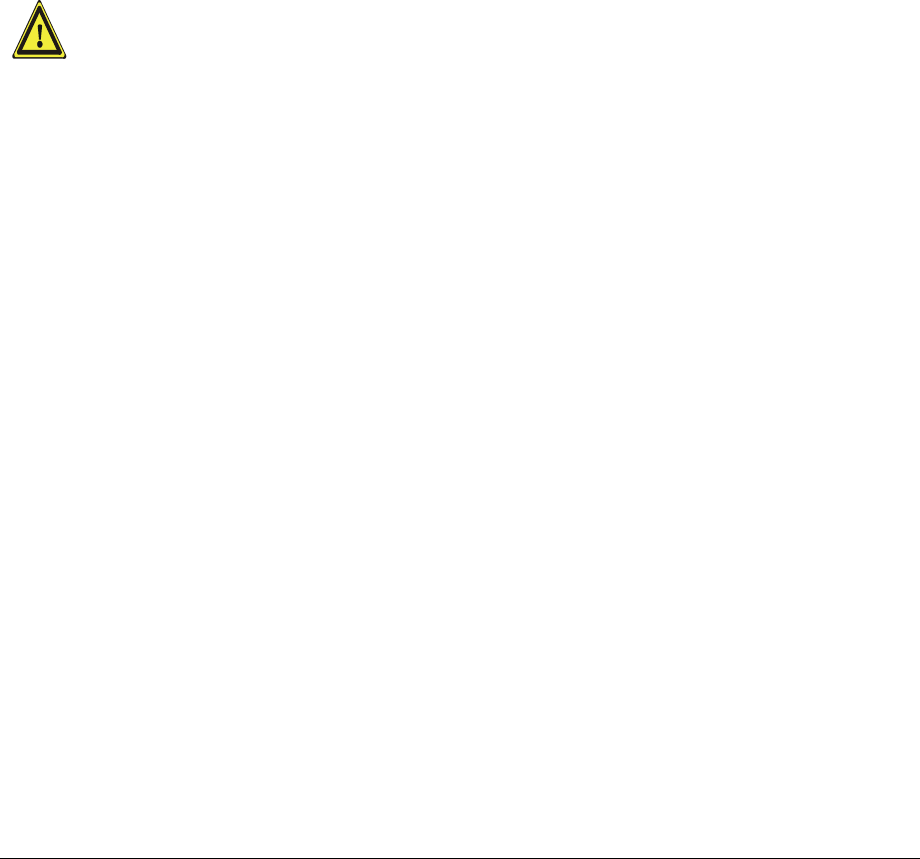
Attenuation: <0.36 dB / km @ 1310 nm / <0.26 dB / km @ 1550 nm
Dispersion: <3.5 ps / nm km @ 1310 nm / <18.0 ps / nm km @ 1550 nm
The specified bending radius of the optical fibres must not be exceeded. The pigtails
for the connection between Master Unit and Remote Unit must have a sufficient
length. A protection for the feeding into units must be given. The system attenuation
of the optical fibres, including the connectors, must not exceed 10 dB.
System attenuation and attenuation of optical components must be determined. This
can be achieved by measuring attenuation and reflection with an appropriate
measuring instrument. For pigtails, a total value of < 0.4 dB (measured to a reference
plug) can be assumed due to the dead zone of the reflectometer. These
measurements must be made with a sufficient length of optical fibre, at the input and
output of the device which has to be measured.
Fibre-cable connectors have to be of the same type (E2000APC8°) as the
connectors used for the unit. The fibre-optic cables are connected to the optical
transceiver.
Angled connectors are not compatible with straight optical connectors;
non-compatibility of connectors will result in permanent damage to
both connectors.
Before connecting the fibre cables, follow the procedure below to ensure optimized
performance. It is important for these procedures to be carried out with care:
Remove fibre-optic protective caps.
Do not bend the fibre-optic cable in a tight radius (< 4 cm) as this may cause
cable damage and interrupt transmission.
Using high-grade alcohol and lint-free cotton cleaning swabs, clean the end of
the fibre-optic cable that will be inserted in the optical connectors on the donor
interface box.
Blow out the laser receptacle with clean and dry compressed air to remove
any particulate matter.
Connect the fibre-optic cables by inserting the cable end into the laser
receptacle and aligning the key (on the cable end) with the keyed slot.
Do not use any index-matching gels or fluids of any kind in these connectors.
Gels are intended for laboratory use and attract dirt in the field.
Page 23 MF0145A8A_FCC modif.doc
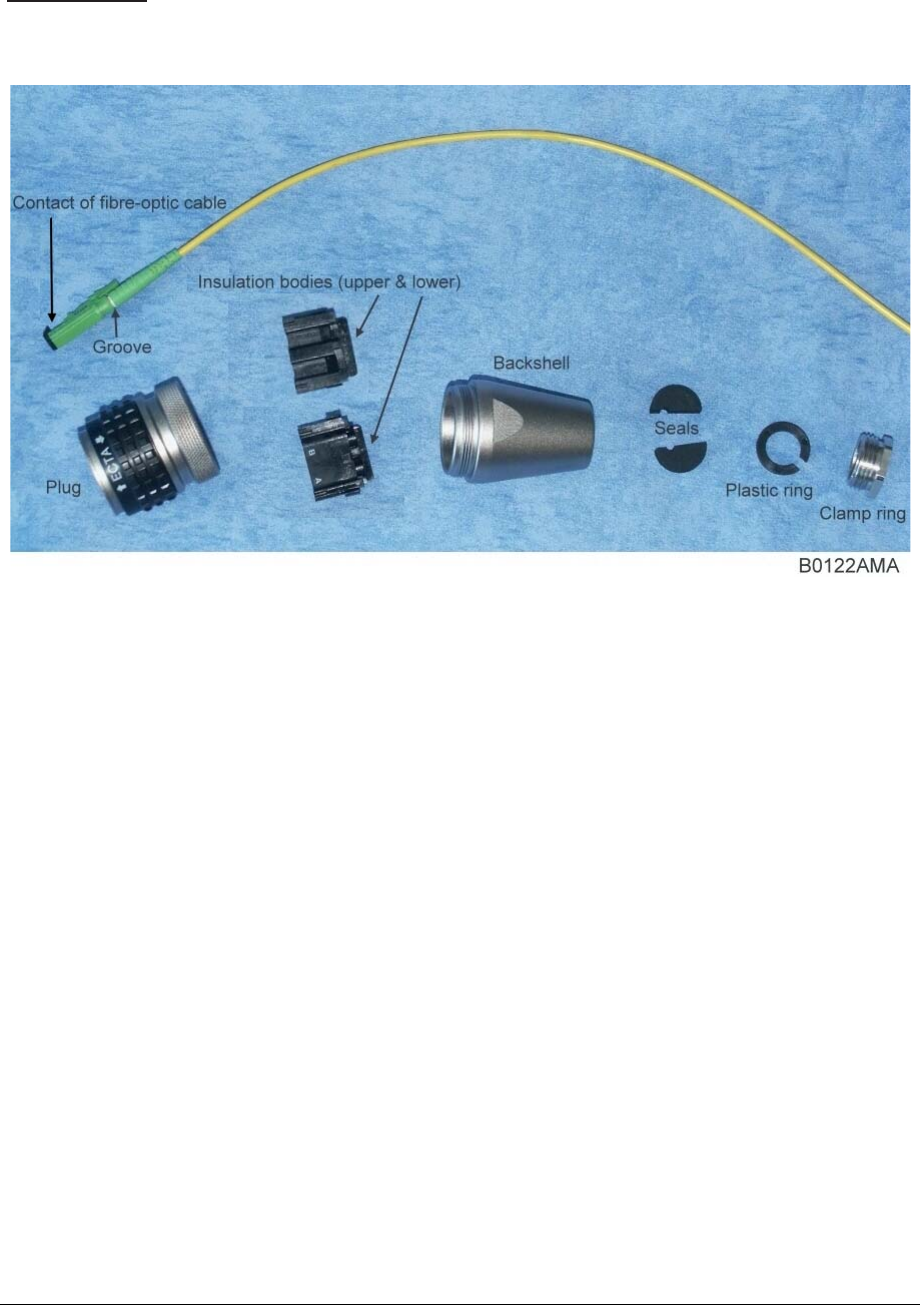
3.2.7. Protective Plug
Connection:
A protective plug is provided for the connection of the fibre-optic cables.
figure 3-8 Protective-plug assembly
Note: Only high-quality connectors must be used for this type of plug.
Qualified brands are Diamond or Huber & Suhner.
Page 24 MF0145A8A_FCC modif.doc
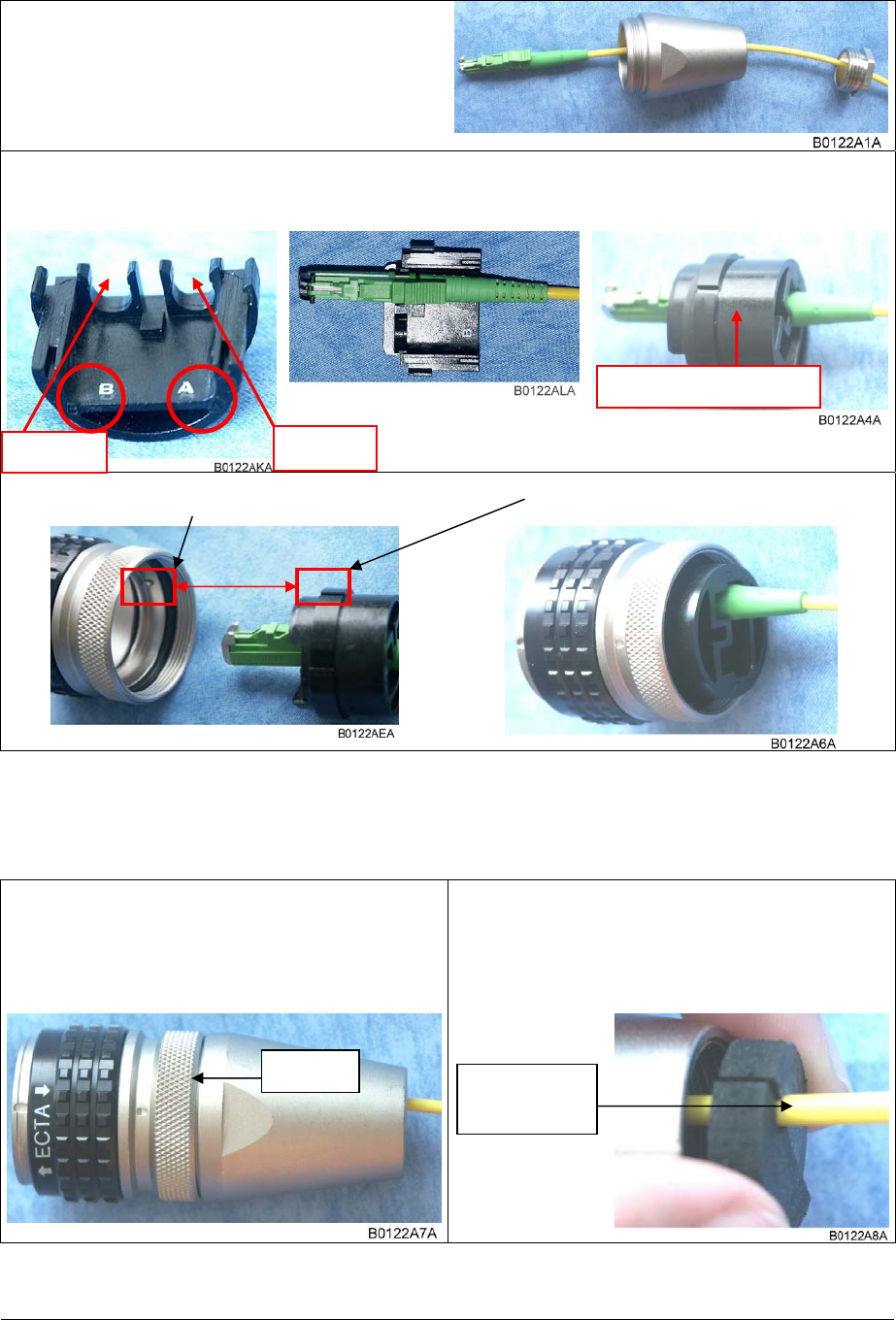
For plug assembly, observe the following instruction:
1. Pass one or two contacts through the
backshell and the clamp ring.
2. Place the contact(s) on the lower insulation body by pushing the groove of the
contact into the cavity. If there is only one contact, cavity A must be used. *
3. Then, mount the upper insulation body on the lower insulation body. **
4. Bring the insulator into the plug. The narrow groove of the insulator must be fitted
into the stamp of the plug.
Page 25 MF0145A8A_FCC modif.doc
* To release the contact for disassembling, push the inner snap to the side and pull the contact out.
** To release upper and lower insulation bodies for disassembling, use a small screwdriver and
carefully open the snap-connections at the left and the right side of the insulator without
damaging them.
5. Fasten the insulator by screwing the
backshell tight onto it. Use a spanner
with opening 32 to screw the
backshell tight (no gap).
6. Place the appropriate seal parts (with
one groove for one contact or two
grooves for two contacts) over the
cable(s) and push them into the
backshell.
Seals with
one groove
No gap
Cavity B
Upper insulation body
Cavity A
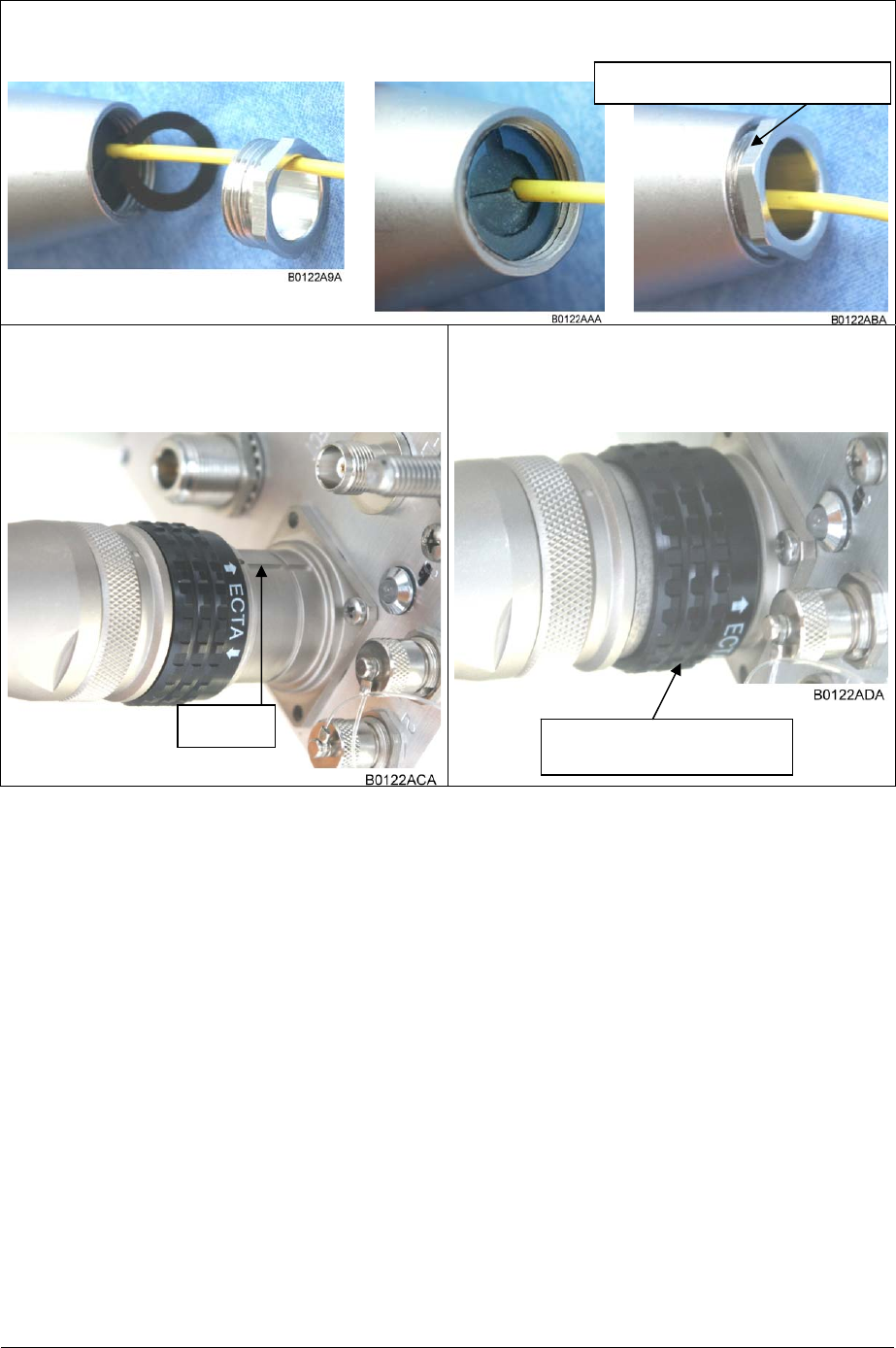
7. Bring the plastic ring over the cable(s), push it into the backshell and compress
the seals and plastic ring by screwing the clamp ring tight (no gap) using a
spanner with opening 20. ***
8. Connect the plug to the optical-fibre
connector of the remote unit, again by
fitting a stamp on the plug into the
groove of the connector.
9. To lock the connector, push the black
locking ring forward.****
Screw tight until gap is closed
Page 26 MF0145A8A_FCC modif.doc
*** For disassembling, release the clamping ring and remove the seals and the plastic ring first.
**** Locking mechanism: The system of locking the plug is based on a “push-pull” mechanism. The
locking ring has to be pushed forward to lock the connector and pulled back to free the
connection.
3.2.8. Protective-Tube Kit
As additional protection for the optical fibers, this connector type can be
supplemented by a special tube kit. To fasten the tube correctly, first unscrew the
clamp ring (if already installed) of the original plug kit.
Then, proceed according to the following instruction:
Groove Push forward to lock, pull
back to free connection
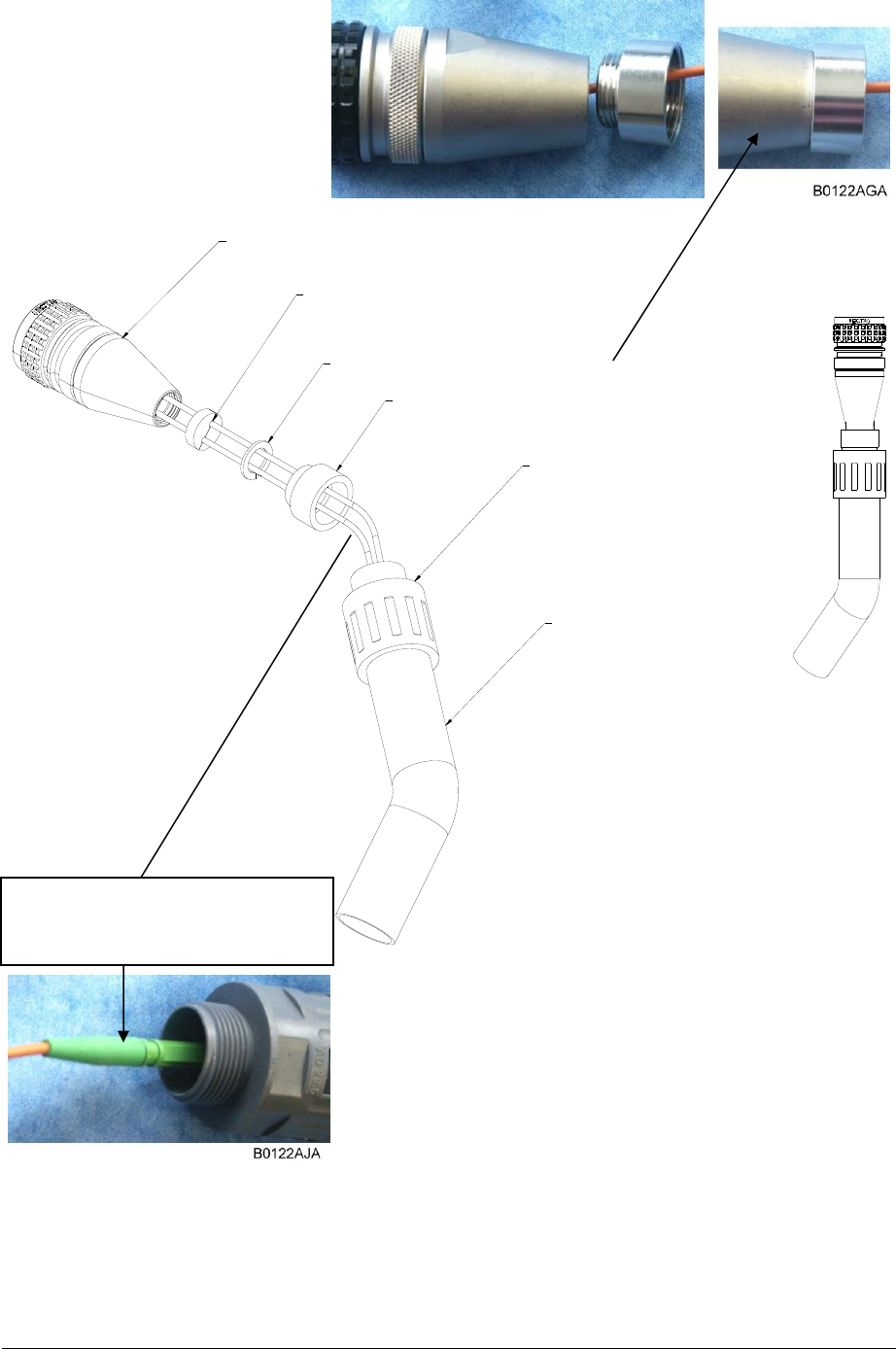
Page 27 MF0145A8A_FCC modif.doc
Screw the reducer to
the protective plug
backshell without any
gap!
Place the appropriate seal
parts (with) one groove for
one contact or two grooves
for two contacts) over the
cable(s) and push them into
the backshell! Protective tube
Reducer
Coupling
Protective plug
Fiber cable
Ring 3/4
G1055M0
figure 3-9 Tube-kit installation
Push the fiber-optic cable carefully
through the tube until it comes out
at the other end.
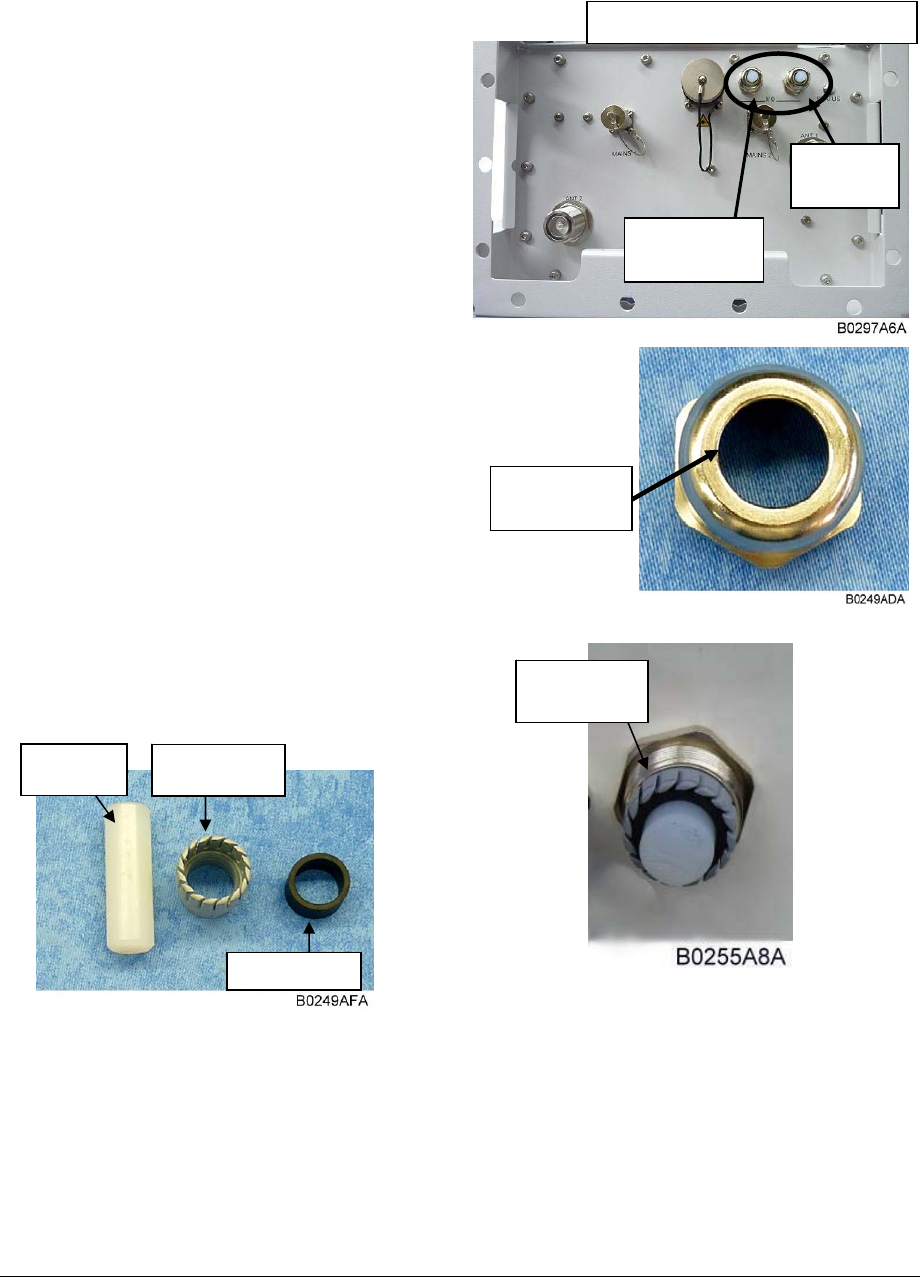
3.2.9. Connection of External-Alarms Cable
To connect the external alarms cable inside the RU to the inputs and/ or outputs of
the external alarm connector, proceed as follows:
Page 28 MF0145A8A_FCC modif.doc
1. Loosen the sleeve nut provided for
the external alarm inputs/ outputs
connector from the cable gland on
the connector flange with the help
of an open-end wrench (of size 20
mm).
2. Remove the seal insert (black) and
plastic rod cut (white) from the
clamp seal (grey).
3. Outside the RU first fit the sleeve nut and second the clamp seal of the cable
gland onto the external alarms cable.
4. Insert the external alarms cable together with the corresponding seal insert into
the cable-gland feedthrough.
5. Fasten the sleeve nut on top of the cable gland again with the help of the open-
end wrench (of size 20). Note: Ensure tightness of the screw!
Sleeve nut
removed
Nut
removed
Rod cut Clamp seal
Seal insert
2 cable glands for connection of
Alarm
output
External
alarm input
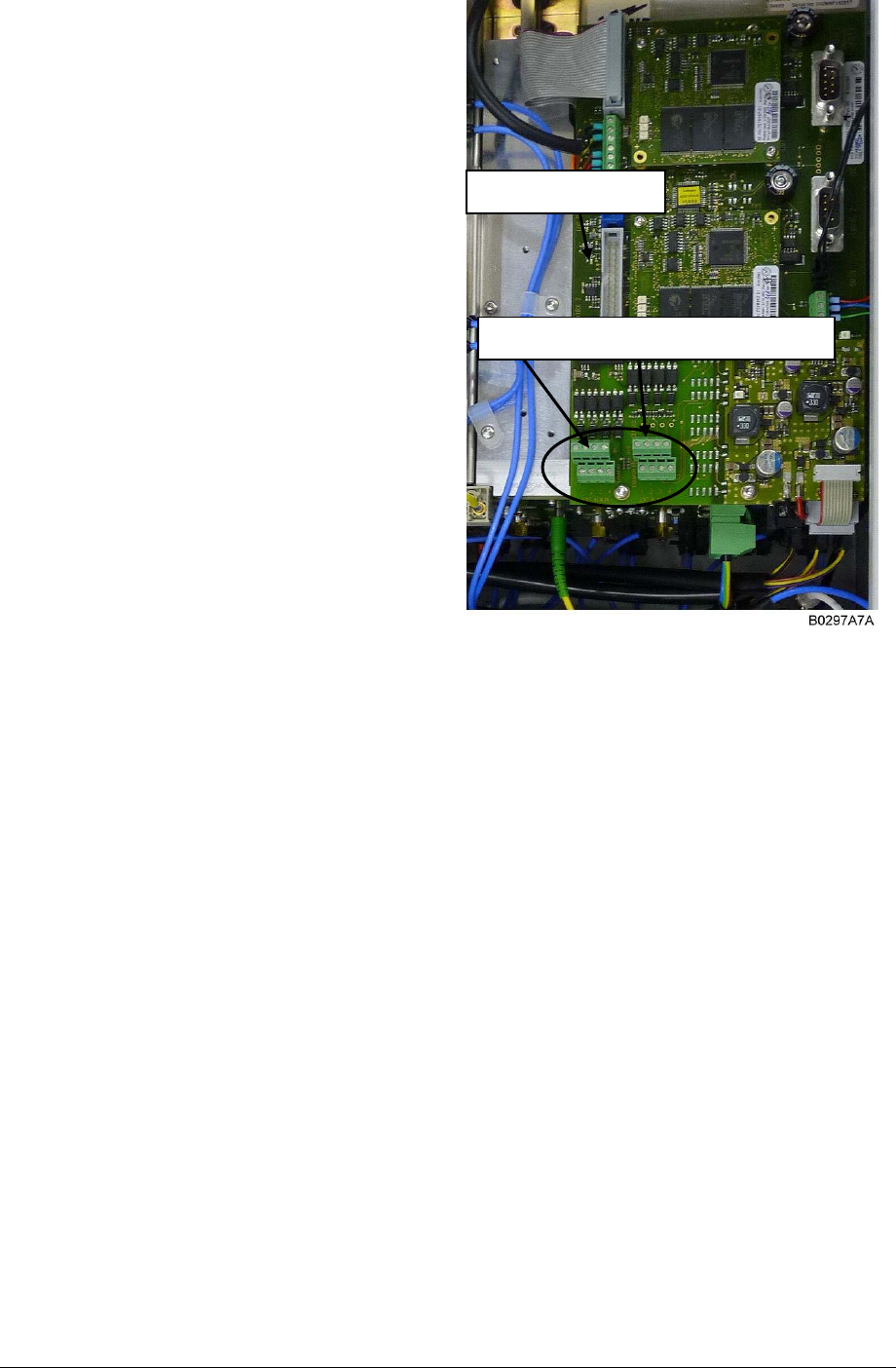
6. Connect the mains cable to the
clamps (part of the delivery)
provided at the external alarm
input/ output connector block
located at the application board in
the interior of the RU.
For more detailed information on the external alarm inputs and outputs please refer
to chapters 4.5.1 External-Alarm Inputs and Outputs and 4.5.2 Layout and
Connector Description.
Application board
Page 29 MF0145A8A_FCC modif.doc
3.3. COMMISSIONING
Read the health and safety warnings in chapter 1.2 as well as the description
carefully to avoid mistakes and proceed step by step as described!
Do not operate the Remote Unit without terminating the antenna connectors.
The antenna connectors may be terminated by connecting them to their
respective antennas or to a dummy load.
Only qualified personnel should carry out the electrical, mechanical,
commissioning and maintenance activities that require the unit to be powered
on when open.
When opening the Remote Unit do not damage the warranty labels on the
internal devices. The warranty is void if the seals are broken.
Ensure that all connections have been performed according to chapter 3.2.2
Connections.
Connecting clamps of external alarms
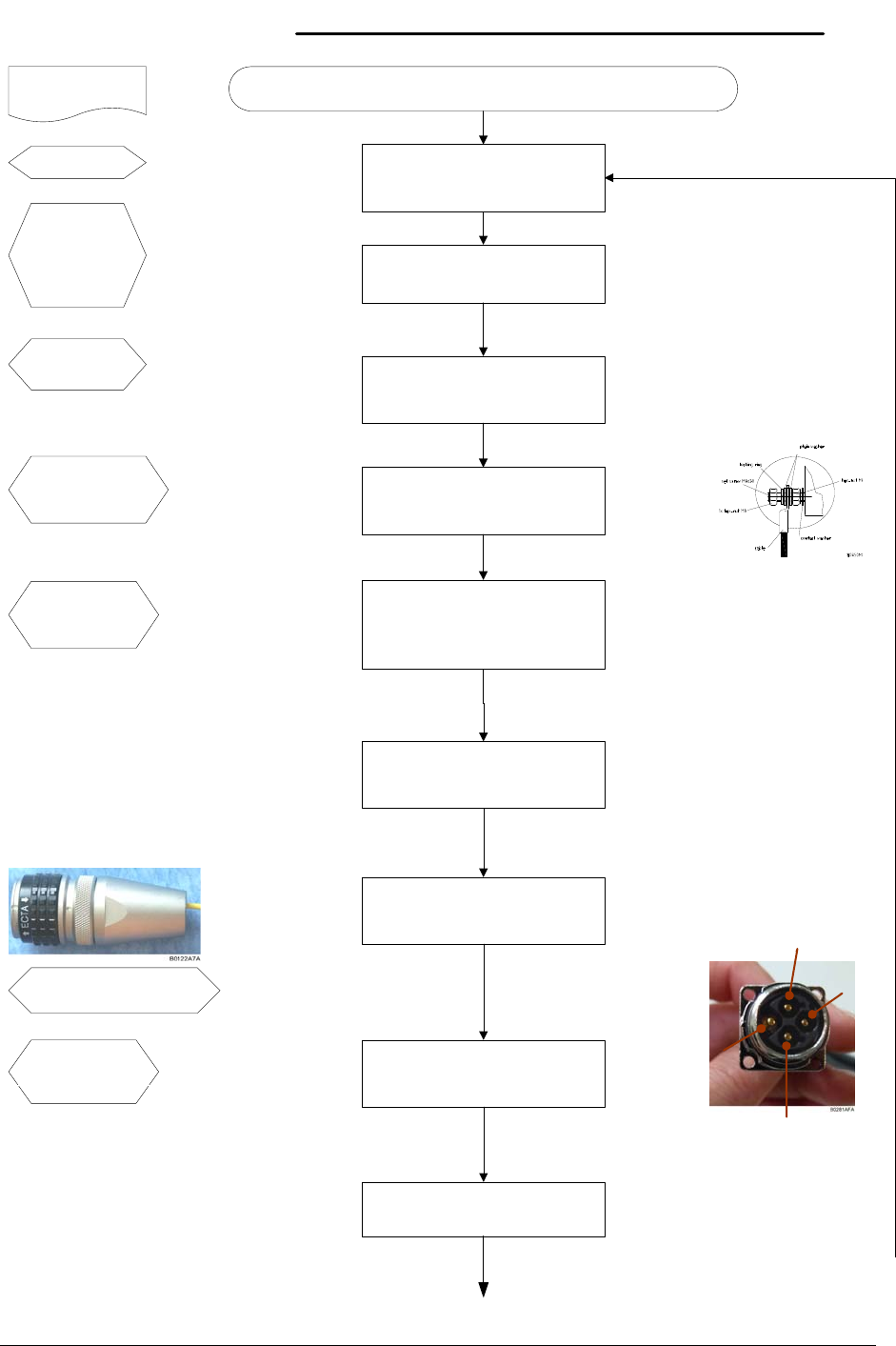
Commissioning an ION-M Remote Unit
Start
Mechanical installation
Fasten wall or pole mounting kit to wall or
pole.
Manual for Remote
Unit
Electrical connections
Connect grounding cable and
ground the RU.
Mains
Switch mains power on.
Philips
screwdriver
Screw driver
Spanner, size
13 mm
Electrical connections
Connect AC power to the power cable.
Ensure there is a circuit breaker between
mains and RU.
RF connection
Connect antenna cable to antenna port.
Optical connections
Mount the optical fibre with E2000 APC8°
connector into the connector. Plug the
connector into the RU.
Mechanical installation
Mount RU to mounting kit, ensure suffient
air flow and avoid thermal short circuits.
Preperation
Unpack RU, RU accessories and
mounting kit.
External devices
Connect external devices to the external
in or alarm out connectors, or to the
connecting board inside the RU.
Mounting kit
Spanner, size
13 mm
Drilling
machine
Dowels
Screw driver
Grounding cable
Spanner 13 mm
Mains cable
Connecting kit
Alarm kit
(M-cabinet)
E2000 APC8° connector
Spanner with opening 32
PIN 1 - L
PIN 2 - N
PIN 3 - n.c.
PIN 4 - PE
Page 30 MF0145A8A_FCC modif.doc
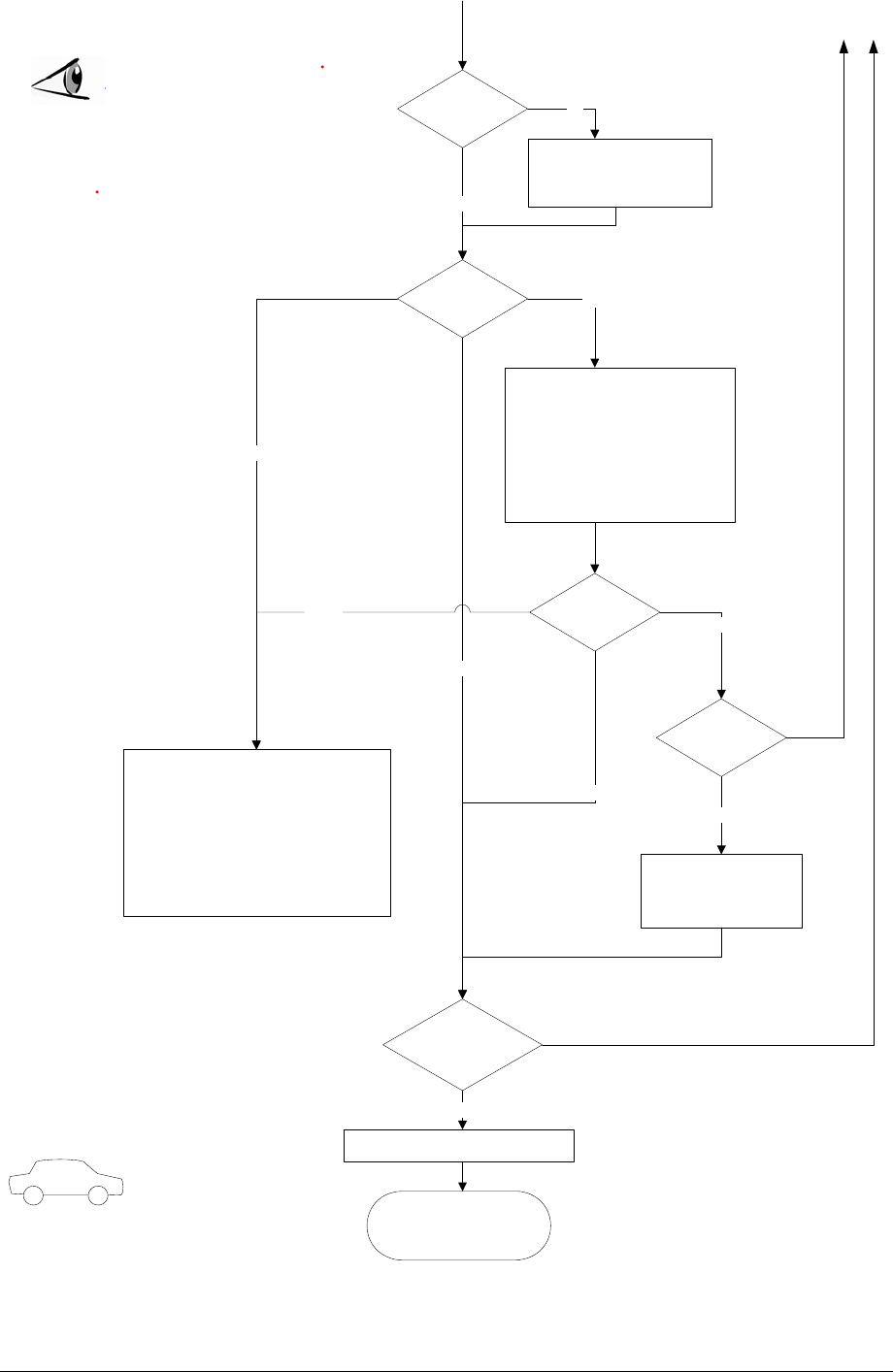
Output:
All RUs okay.
Go to MU
External error
Close the door (RUs with a door).
Check externally connected devices.
Check fibre loss of optical link.
Check optical connectors.
Clean optical connectors.
Check optical output power of corresponding
OTRx at master unit.
ALC alarm: Decrease DL input power of
affected band.
VSWR alarm: Check antenna and cable.
LED status
Proceed to MU to set up the SW
Orange
Yes
Internal Error
Change power supply (RUs with a
door).
Reduce environmental temperature.
Eliminate thermal short circuit.
Disconnect and connect mains. Fans
should run. If not, replace the fans at
RU.
MU: Change amplifier setting at MU
controller
Red
LED statusYellow
Green
Red
Finished setting up
all RUs?
Green
Spare RU
available?
Yes
Contact customer
service
No
Yes
LED on?
Check power switch inside RU
(RUs with door).
Check mains cabling.
Check mains power.
No
No
Page 31 MF0145A8A_FCC modif.doc

Page 32 MF0145A8A_FCC modif.doc
For your notes:

Page 33 MF0145A8A_FCC modif.doc
4. ALARMS
4.1. BITE AND ALARMS
The Built-In Test concept comprises the monitoring of the power supplies, the power
amplifiers and the optical interface.
All occurring alarms can be checked via software at the Master Unit.
4.2. HANDLING OF ALARMS
As soon as the software acknowledges a valid alarm, a message is transmitted to the
Master Unit.
If the reason for the alarm has been cleared or if the alarm should continue, a new
alarm message will not be repeated. If there was an interruption of at least five
seconds after acknowledgement, a new alarm message will be generated.
4.3. ALARM STATUS
For details refer to the corresponding software documentation of the Master Unit.
4.4. STATUS LED ALARMS
For local supervision, a status LED on the connector flange of the remote unit gives
an indication of possible reasons for alarms. This table shows possible on-site
measures that could be checked before referring to the master unit alarm list.
Status LED Indication Alarms Possible on-site measures
Green No alarm
Status ok
Door alarm Close the door (RUs with door).
Alarms not directly related to RU:
External alarms Check externally connected devices.
Optical alarm Rx
Check fibre loss of optical link.
Check optical connectors.
Clean optical connectors.
(MU: Check optical output power of
corresponding OTRx at master unit).
Orange
ALC alarm (MU: Decrease DL input power of
affected band).
Alarms directly related to RU:
Red
Power 28 V Change power supply (RUs with door).
Replace the affected remote unit.

Page 34 MF0145A8A_FCC modif.doc
Temperature Reduce environmental temperature.
Eliminate thermal short circuit.
Fan Disconnect and connect mains. Fans
should run. If not, replace the fans at
RU.
I²C Disconnect and connect mains.
Optical alarm Tx Exchange RU.
A
mplifier “Power
Down” (MU: Change amplifier setting at MU
controller).
Status LED off Mains
Check power switch inside of RU (RUs
with door).
Check mains cabling.
Check mains power.
table 4-1 Status LED alarms
For the position of the status LED see chapter 3.2.2 Connections.
Explicit troubleshooting is available in the MU software (software manual or WEB
Interface).
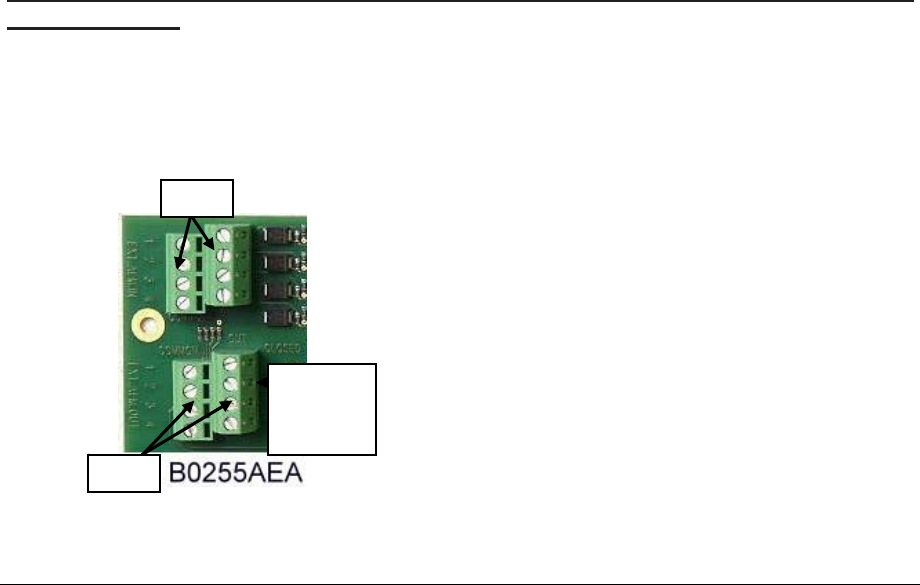
4.5. APPLICATION BOARD
4.5.1. External-Alarm Inputs and Outputs
There are four alarm inputs and four alarm outputs. The alarm outputs are potential-
free relay contacts. They can be used to monitor alarms with an external-alarm
indicator. Each alarm output can be set individually to any alarm at the Remote Unit.
For details please refer to the according chapter in the software manual of the master
unit.
Note: The manufacturer / supplier of this system accepts no liability for
damage caused by equipment connected to external outputs or by
effects from such equipment.
With the external-alarm inputs, it is possible to monitor the status of connected
devices, e.g. a UPS, via software. All alarm inputs are normally high (5 V) without
connection.
The device to be monitored must be connected so that the alarm contacts will be
closed in case of an alarm (0-5 V, max. 7 mA each input)
The location of the external-alarm inputs and outputs is illustrated in the following
chapter 4.5.2 Layout and Connector Description. Settings have to be done via the
ION-M Master Controller and are described in the according software documentation.
Please note that at the Remote Unit (RU), the external-alarm inputs (outputs-
optocoupler version) are optically decoupled.
Designation of External-Alarm Connectors for the ION-M7HP/7HP/85HP/19P (in
the W-cabinet):
X13 & X19 => alarm inputs and outputs with optocoupler
X13 & X14 => alarm inputs with optocoupler, alarm outputs with relays
Standard version: Optocoupler outputs => relays not equipped
Page 35 MF0145A8A_FCC modif.doc
The connecting clamps for the external alarm
inputs and alarm outputs are located at the
lower left-hand side (when standing in front of
the opened RU base) of the application board
For the layout of the application bard please
refer to the illustration in chapter 4.5.2 Layout
and Connector Description and/ or to that in
chapter 3.2.9 Connection of External-Alarms
Cable, bullet point 7) For the exact designation
of the connectors, please see picture to the left-
hand side.
X13
Position
of
X14
X19
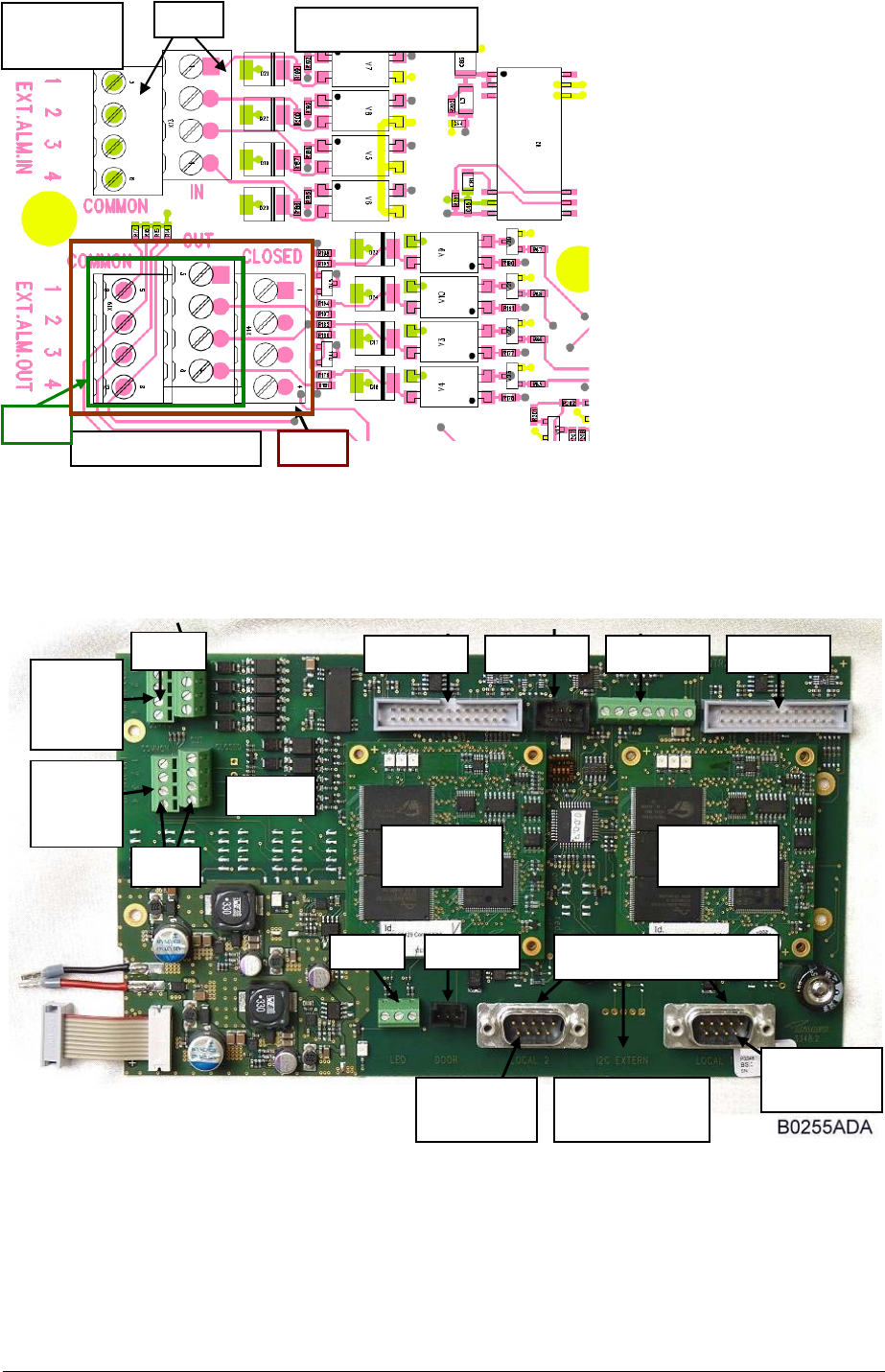
Page 36 MF0145A8A_FCC modif.doc
figure 4-1 External-alarm inputs and outputs, location
4.5.2. Layout and Connector Description
* in standard version X14 is not equipped G3194X006
figure 4-2 Application board, connectors
Ext. alarm
inputs X13 Application board
X19
Ext. alarm out
p
uts X14 P3348B0
X13 I
2
C BBU
FAN
OTRx 2 OTRx 1
Ext.
Alarm
INPUT
Ext.
Alarm
OUT
X14 *
Core
module 1 Core
module 2
X19
LED DOOR only for maintenance
RS232
LOCAL 1
I
2
C external
not equipped
RS232
LOCAL 2
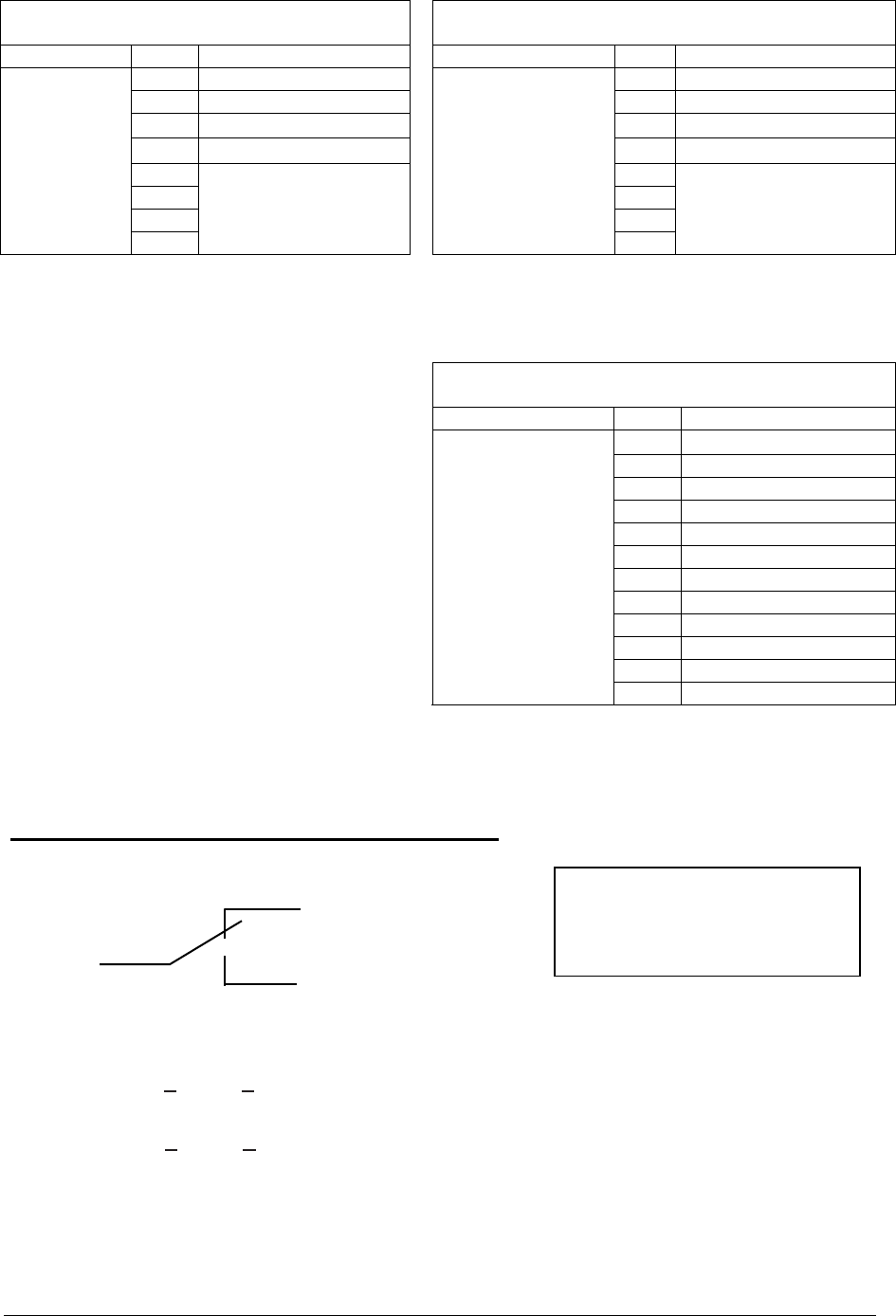
External-Alarm Inputs
with Optocouplers Variant A)
External-Alarm Outputs with Optocouplers
Connector Pin Description Connector Pin Description
1 IN1_EXTERNAL 1 OUT1_EXTERNAL
2 IN2_EXTERNAL 2 OUT2_EXTERNAL
3 IN3_EXTERNAL 3 OUT3_EXTERNAL
4 IN4_EXTERNAL 4 OUT4_EXTERNAL
5 5
6 6
7 7
X13 1) =
INPUTS
8
GND_ISOLATED
X19 2) =
OUTPUTS
8
GND_ISOLATED
1) Voltage: 0 - 5 V;
Current: max. 7 mA (on each input) 2) Pull up tied to +5 V (on each output)
Voltage: 0 V or +5 V; I sink max. = 2 mA;
Alarm active high
Variant B:
External-Alarm Outputs with Relays
Connector Pin Description
1 OUT1_NC
2 OUT2_NC
3 OUT3_NC
4 OUT4_NC
5 OUT1_NO
6 OUT2_NO
7 OUT3_NO
8 OUT4_NO
9 OUT1_CO
10 OUT2_CO
11 OUT3_CO
X14 3) =
OUTPUTS
12 OUT4_CO
3) Voltage: +28 V, current: max. 0.4 A
table 5 3 External-alarm inputs and outputs, PIN assignment
Relay Contacts on the External-Alarm Output
Page 37 MF0145A8A_FCC modif.doc
figure 4-3 External-alarm outputs, relay contacts in alarm condition
1) NC = abbrev. of "Normally Closed (contact)" (a.ka. break contact)
In non-energized position of the relay, this contact is closed and opens after coil energization
2) NO = abbrev. of "Normally Open contact (a.k.a. make contact),
In non-energized position of the relay, this contact is open, and will be closed after coil energization.
3) CO = abbrev. of "Change Over (contact (a.ka. double throw)
This contact is the common contact configuration comprising both NC and NO contacts electrically
connected. With switching, the CO contact changes between NC and NO.
External-Alarm Output
Output voltage: 28 Vdc
Output current: 0.5 A
NO = Normally Open
2
)
CO =
Change Over 3)
("common")
NC = Normally Closed
1
)
In non-energized position /
alarm condition
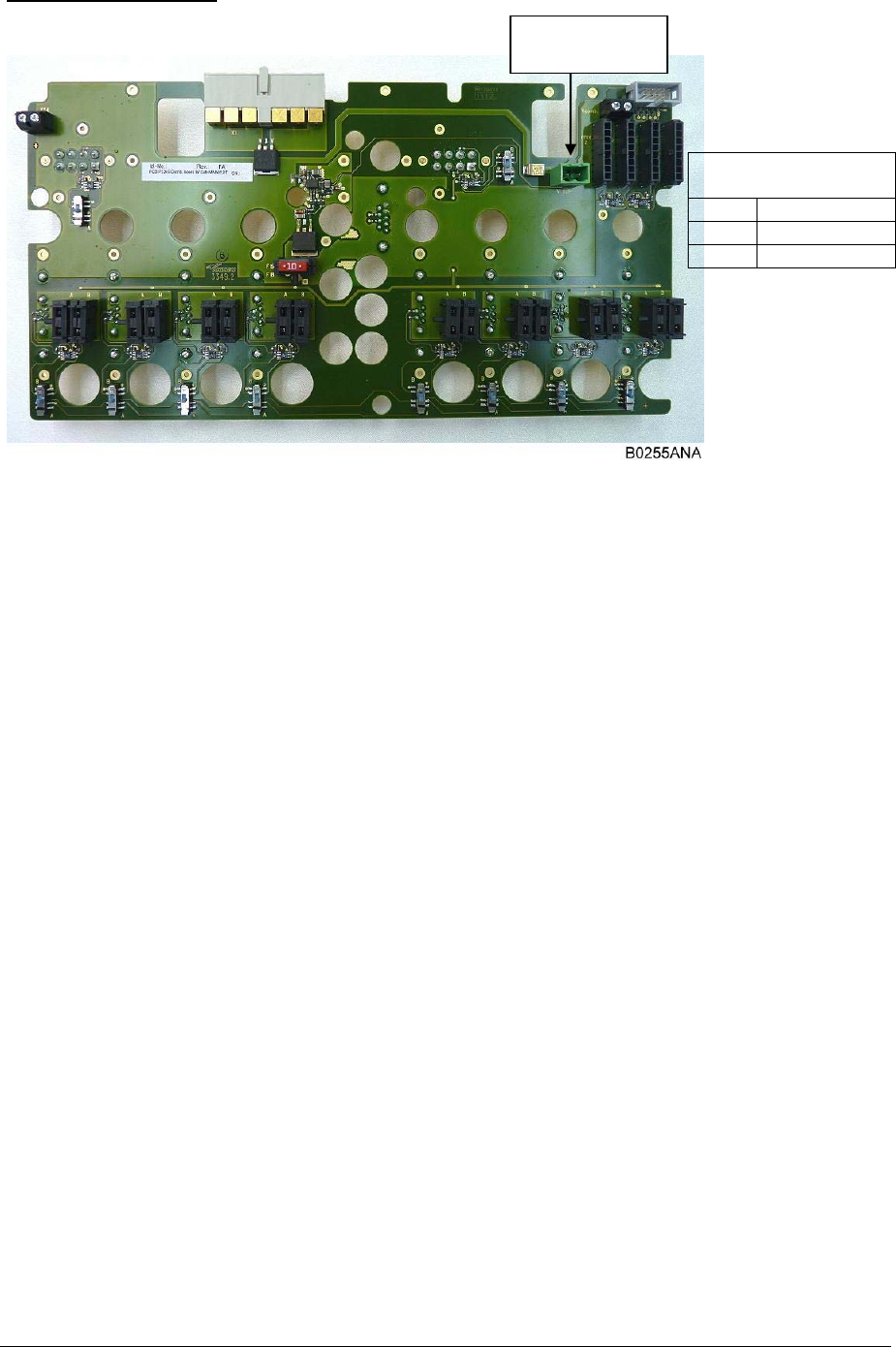
28 V DC Connector
Page 38 MF0145A8A_FCC modif.doc
figure 4-4 28 V DC connector, location on distribution board
The 28 V DC connector denomminated connector "X7" is located on top of the
distribution board.
The 28V DC connector serves for connection of external devices (e.g. VSWR
module).
4.6. TROUBLESHOOTING
The status of the Remote Unit can be checked via the Master Unit (for details please
refer to the software manual of the Master Controller). Locally, the status can be
checked at the LED, see chapter 4.4 Status LED Alarms.
Connector X7
28 V DC
Pin Description
1 +28 V
2 GND
28 V DC
connector X7
Distribution board – top side
(uninstalled)

Page 39 MF0145A8A_FCC modif.doc
5. MAINTENANCE
5.1. GENERAL
Read the health and safety warnings in chapter 1.2.
Note: The Remote Unit does not require preventative maintenance
measures.
Note: To prevent malfunctions of the cooling system due to dirt or
pollution, it is recommended to clean the heat sink at regular
intervals. These cleaning intervals depend mainly on the location
of the Remote Unit and the corresponding degree of pollution.
Maintenance of the ION-M7HP/7HP/85HP/19P should be performed by replacing
only components that are contained in this chapter. In order to maintain warranty,
take care not to damage unintentionally the seals on the modules.
The spare parts list, consequently, contains only units which can be replaced without
tuning or soldering work.
Note: When sending back the unit, use an appropriate packaging, see
chapter 6.2.2 Mechanical Specifications. We strongly recommend
using the original packaging!
Note: Defect parts should only be replaced by original parts from the
supplier. All interventions inside the housing are at one’s own risk.
Note: During maintenance ensure the Remote Unit has been
disconnected from mains.
Note: Before disconnecting any cables, label any unlabelled cables to
ensure correct connection.
For most maintenance procedures appropriate tools are required to ensure correct
handling. All these tools can be ordered from the supplier. For screwing procedures
observe that all our screws have a right-hand thread, i.e. for fastening the screws
turn the tool clockwise and for unscrewing them turn it counter-clockwise.
Due to the design of the Remote Unit the only component recommended to be
replaced is the fan unit. For replacing any other component, please contact the
supplier.
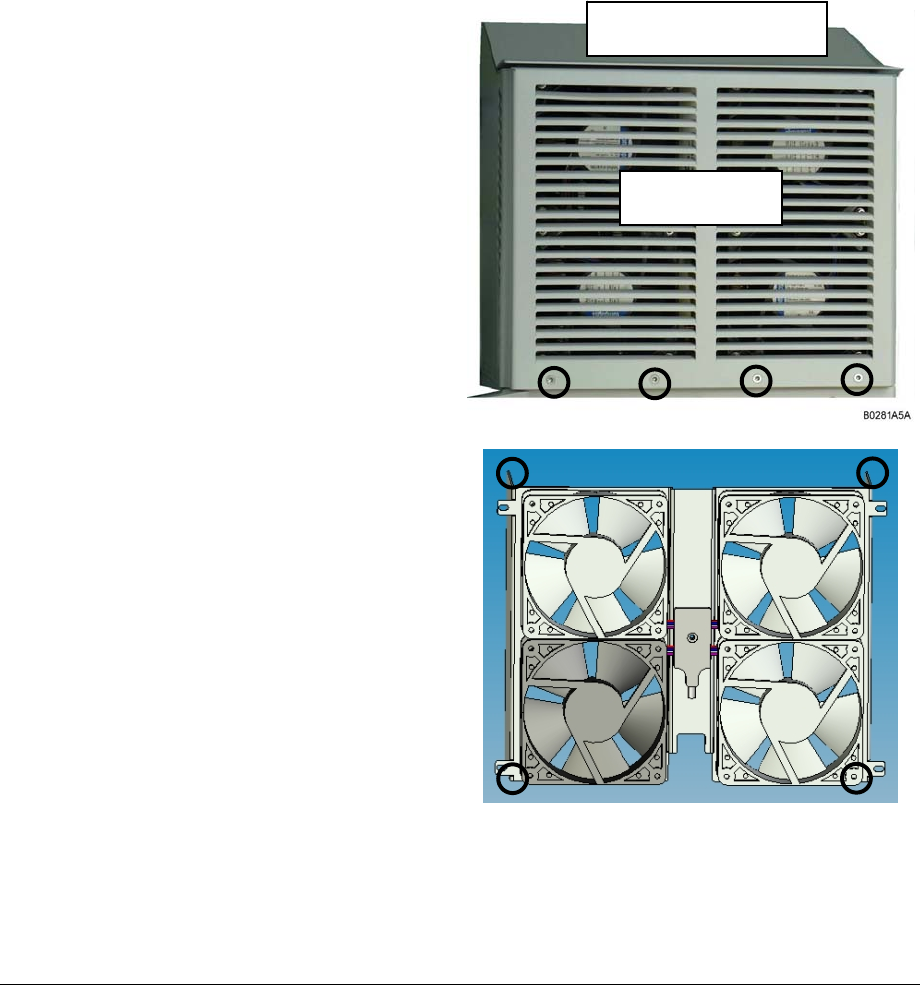
5.2. REPLACING THE FAN UNIT
Replacement of the fan unit is not required as a preventative measure. Only if an
alarm indicates a malfunctioning of a fan must the unit be exchanged.
Note: Please observe that the fan unit can only be replaced as a whole.
Do not remove the fans separately.
Read the health and safety warnings in chapter 1.2 as well as the instructions in
chapter 5.1 General before starting with the replacement.
1. Switch off the Remote Unit. Make sure mains power is disconnected for the
following replacement procedure. Then, proceed as follows:
2. Take the protective cover off the
cabinet by pulling it strongly to the
front (see also chapter 3.1.2 ).
3. Loosen the four tallow-drop screws
M4x8 of the fan guard by which the
fan plate is screwed to the cabinet.
Remove the four screws and the
corresponding washers.
Take out the entire fan plate together with
all four fans.
L_G3194X010
Protective cover
Fan guard
Page 40 MF0145A8A_FCC modif.doc
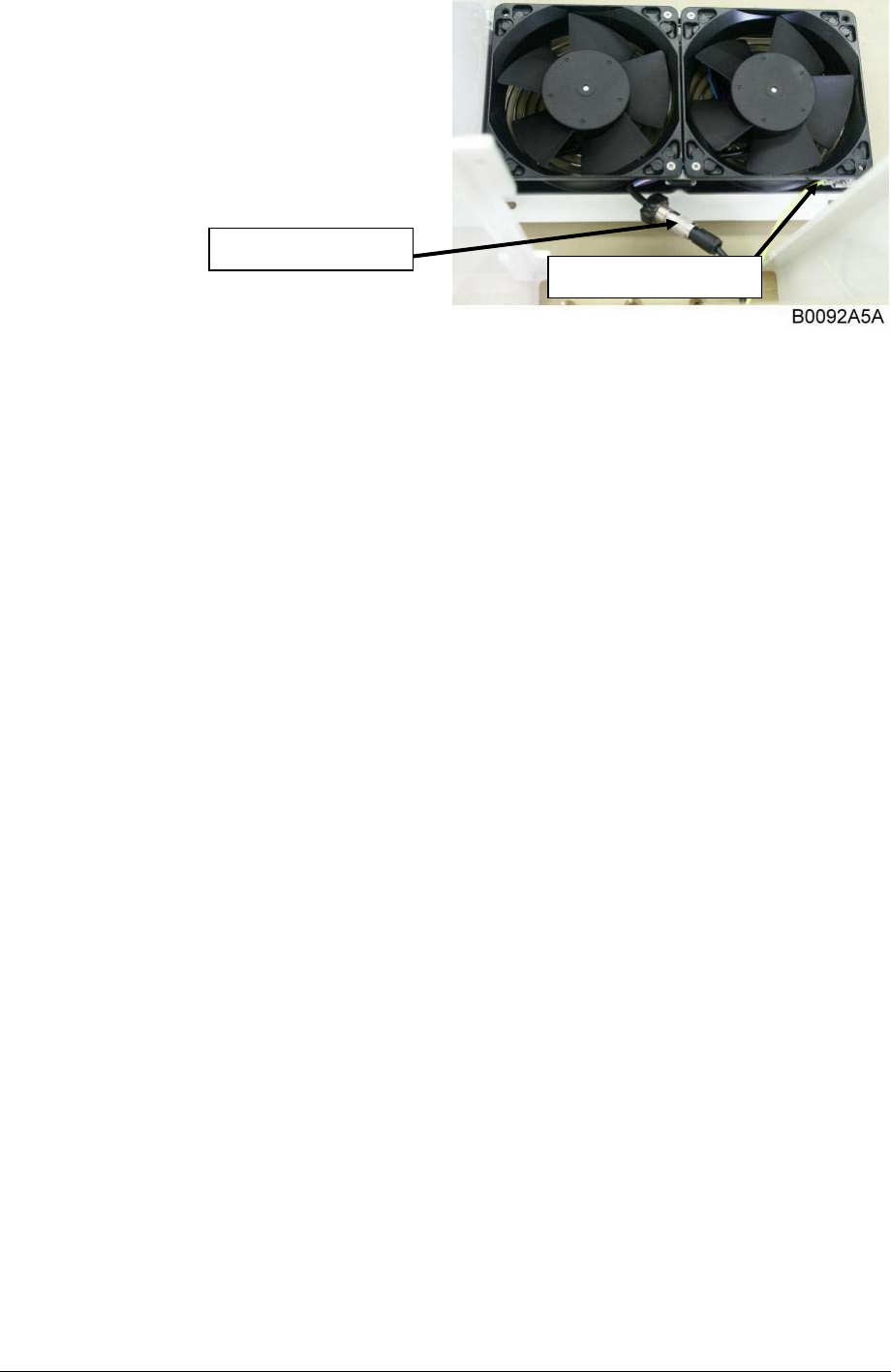
4. Remove the fan unit – by putting slight
pressure on the fan plate cover – to a
position that allows access to the fan
connector and the earth-bonding
cable.
5. Unscrew the fan connector and then
disconnect the earth-bonding cable.
Fan-unit connector
Earth-bonding cable
Note: To observe the specified torque of 650 Ncm for an M5 thread, use
an appropriate tool for the following screwing procedures.
6. To mount the new fan unit, re-connect the earth-bonding cable and the fan
connector (see step 5). Then, place the fan unit back into its original position and
fix it tight.
7. Screw the whole fan unit to the cabinet with the four tallow-drop screws M4x8
(see step 2). In order not to exceed the specified torque of 330 Ncm, use an
appropriate tool.
8. Put the protective cover back on the top of the cabinet (see step 2).
Page 41 MF0145A8A_FCC modif.doc
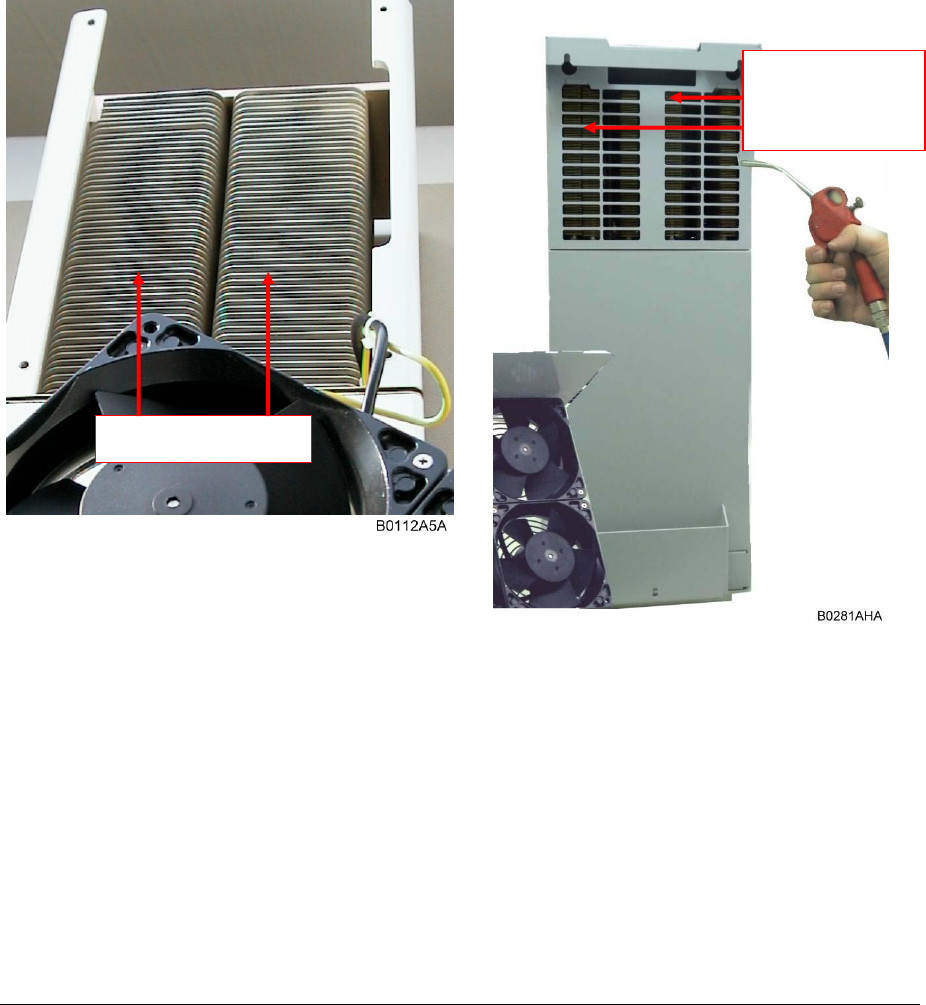
5.3. CLEANING THE HEAT SINK
Note: Read the health and safety warnings in chapter 1.2 as well as the
instructions in chapter 5.1 General before starting with the
replacement procedure. Then, proceed as follows:
1. Switch off the Remote Unit. For the following procedure ensure to have mains
disconnected before!
3. Use compressed air (max. 5 bar) to
blow out the heat sink from back to
front as illustrated in the figure below:
2. Remove the protective cover and the
fan plate with the fan unit from the
Remote Unit as described in chapter
5.2 Replacing the Fan Unit, steps 1
and 2:
4. In case the dirt cannot be blown out
completely and parts of it stick to the
ribs of the heat sink, clean the parts
concerned carefully from the front
using e.g. a brush. Take care that the
material is not scratched or damaged.
Page 42 MF0145A8A_FCC modif.doc
5. After cleaning the heat sink, mount the fan unit and protective cover again
according to chapter 5.2 Replacing the Fan Unit, steps 7 and 8. Then, switch the
Remote Unit back on.
Use
compressed air
(5 bar max.)
Brush (not metallic)
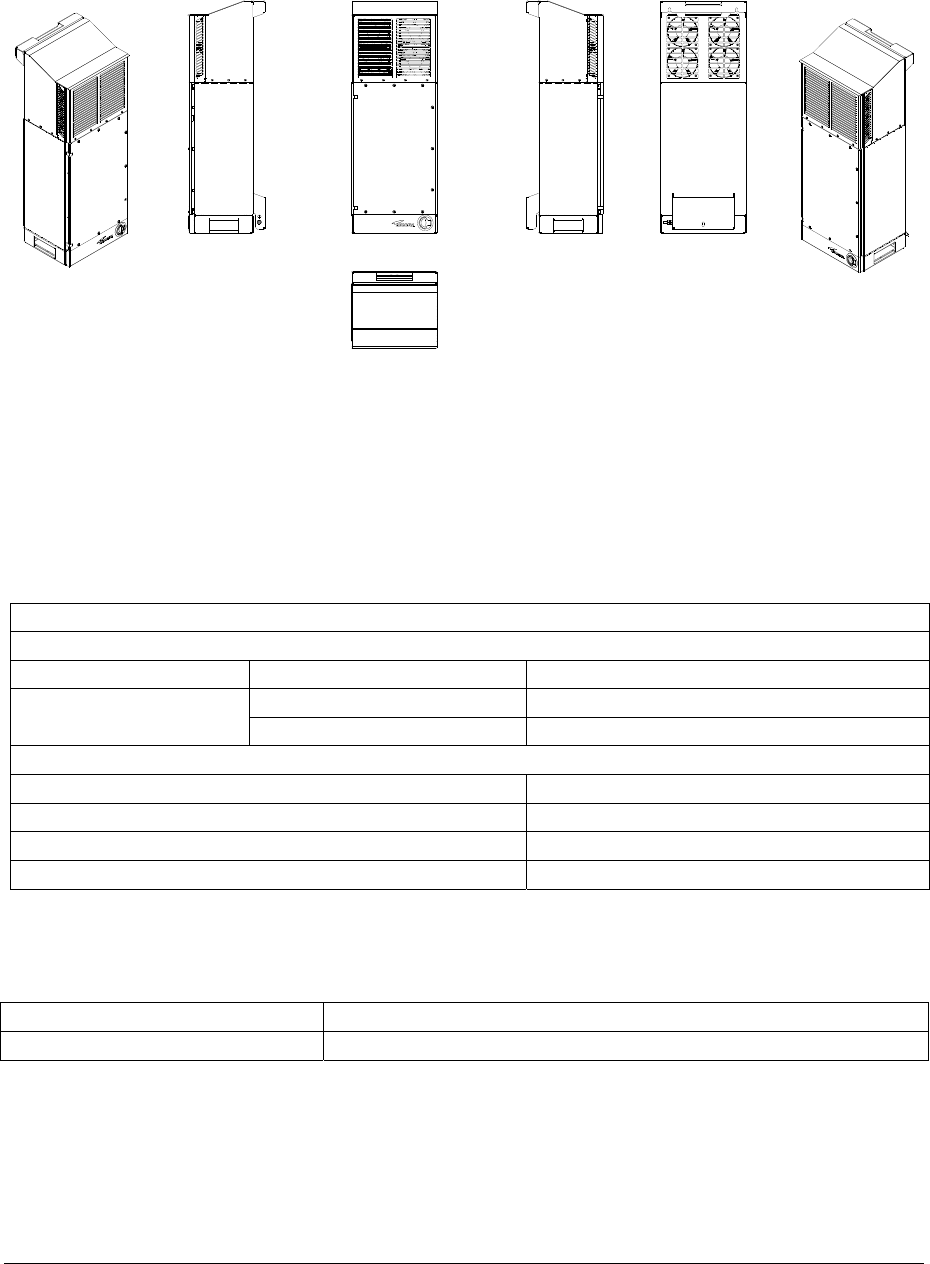
6. APPENDIX
6.1. ILLUSTRATIONS
figure 6-1 Cabinet drawing
6.2. SPECIFICATIONS
6.2.1. Electrical Specifications
ION-M7HP/7HP/85HP/19P
Electrical
Power supply Mains power 100 Vac to 240 Vac
max. temp., fully loaded 1640 W
Power consumption room temp., idle 780 W
Optical Link
Connectors E2000/APC 8°
Optical return loss 45 dB
Fibre type Single mode E9/125 µm
Optical link budget 0 to 10 dB
6.2.2. Mechanical Specifications
Height, width, depth * 900 x 330 x 300 mm (35.4 x 13.0 x 11.8 in)
Weight 55 kg (121 Ib)
* Spacing required 80 mm (3.15 in) around unit
All data is subject to change without notice.
Page 43 MF0145A8A_FCC modif.doc

Page 44 MF0145A8A_FCC modif.doc
6.2.3. Environmental and Safety Specifications
Note: For detailed information, please refer to the Environmental and
Safety Specifications leaflet of the supplier, related to ETS 300 019
(European Telecommunication Standard).
Environmental
Operating temperature range -33 °C to +45°C
RF part IP66
Ingress protection Fan part IP55
All data is subject to change without notice.
6.3. SPARE PARTS
The following list contains all parts available for the Remote Unit. The configuration of
the delivered unit meets the requirements of the customer and can differ depending
on the state of the delivery.
Maintenance of the ION-M7HP/7HP/85HP/19P should be performed on an FRU
(Field Replaceable Unit) basis only. Do not damage the warranty labels on the
components, as this voids the warranty.
If any FRU not contained in the following list needs to be replaced, please contact
customer service for additional instructions.
Spare Parts List of the Remote Unit ION-M7HP/7HP/85HP/19P
Designation ID No
ION-M7HP/7HP/85HP/19P 7643936
Fan Unit W-Cabinet 7619978
Wall Mounting Kit 7635354
Manual for ION-M7HP/7HP/85HP/19P 7653445-00
The manufacturer reserves the right to replace the spare parts listed above by
equivalent substitutes.
Note: Only the spare parts listed above are FRUs (= Field Replaceable
Units) and can be replaced by the user. For replacement of any other
parts, please send the entire Remote Unit back to the manufacturer.

Page 45 MF0145A8A_FCC modif.doc
7. INDEX
A
Abbreviations.......................................................... 5
Alarms
Alarm Status .................................................... 33
Bite and Alarms ............................................... 33
External............................................................ 35
External Inputs................................................. 35
Handling of Alarms .......................................... 33
List ................................................................... 38
Outputs ............................................................ 35
RU ................................................................... 38
Status LED....................................................... 33
Application Board ........................................... 35, 36
Alarm Input Connectors ................................... 36
Alarm Inputs & Outputs.................................... 36
Alarm-Output Connectors ................................ 37
External-Alarm Inputs and Outputs.................. 35
Relays.............................................................. 35
C
Cleaning the Heat Sink......................................... 42
Commissioning
General............................................................ 29
CommScope Solutions ........................................... 8
Connection
External-Alarms Cable..................................... 28
Connection Rules
Optical-Fibre Cables ........................................ 22
Connections
Antenna ........................................................... 20
Connector Flange ............................................ 19
Mains Power AC.............................................. 21
Optical-Fibre Cable.......................................... 22
Power .............................................................. 21
Contact Addresses
Customer Support.................................. 9, 10, 11
Customer Support Addresses..................... 9, 10, 11
D
Declaration of Conformity ....................................... 8
Distribution Board
28 V DC Connector.......................................... 38
E
External-Alarms Cable.......................................... 28
F
Fibre-Sealing Kit................................................... 28
G
Grounding............................................................. 20
H
Health and Safety Warnings................................... 6
I
Illustrations ........................................................... 43
Installation
Electrical.......................................................... 18
Mechanical ...................................................... 15
M
Maintenance......................................................... 39
Mounting
Wall.................................................................. 17
O
Optical-Fibre Connection...................................... 28
Protective Plug ................................................ 24
Protective-Tube Kit .......................................... 26
R
Relay Contacts - External-Alarm Output............... 37
Replacement of Fan Unit...................................... 40
S
Spare Parts .......................................................... 44
Specifications
Electrical.......................................................... 43
Environmental and Safety................................ 44
Mechanical ...................................................... 43
T
Troubleshooting.................................................... 38
V
VSWR Alarming Option........................................ 13